Employee Engagement and Motivation in Healthcare
VerifiedAdded on 2021/04/19
|20
|4334
|28
AI Summary
This assignment provides an overview of employee engagement and motivation in the healthcare sector. It discusses various strategies for improving employee engagement, such as public service motivation, pay-for-performance systems, and effective change management. The assignment also touches on conflict management training and its impact on employee outcomes. Additionally, it covers topics like stress management, occupational therapy, and human performance improvement in the healthcare context.
Contribute Materials
Your contribution can guide someone’s learning journey. Share your
documents today.
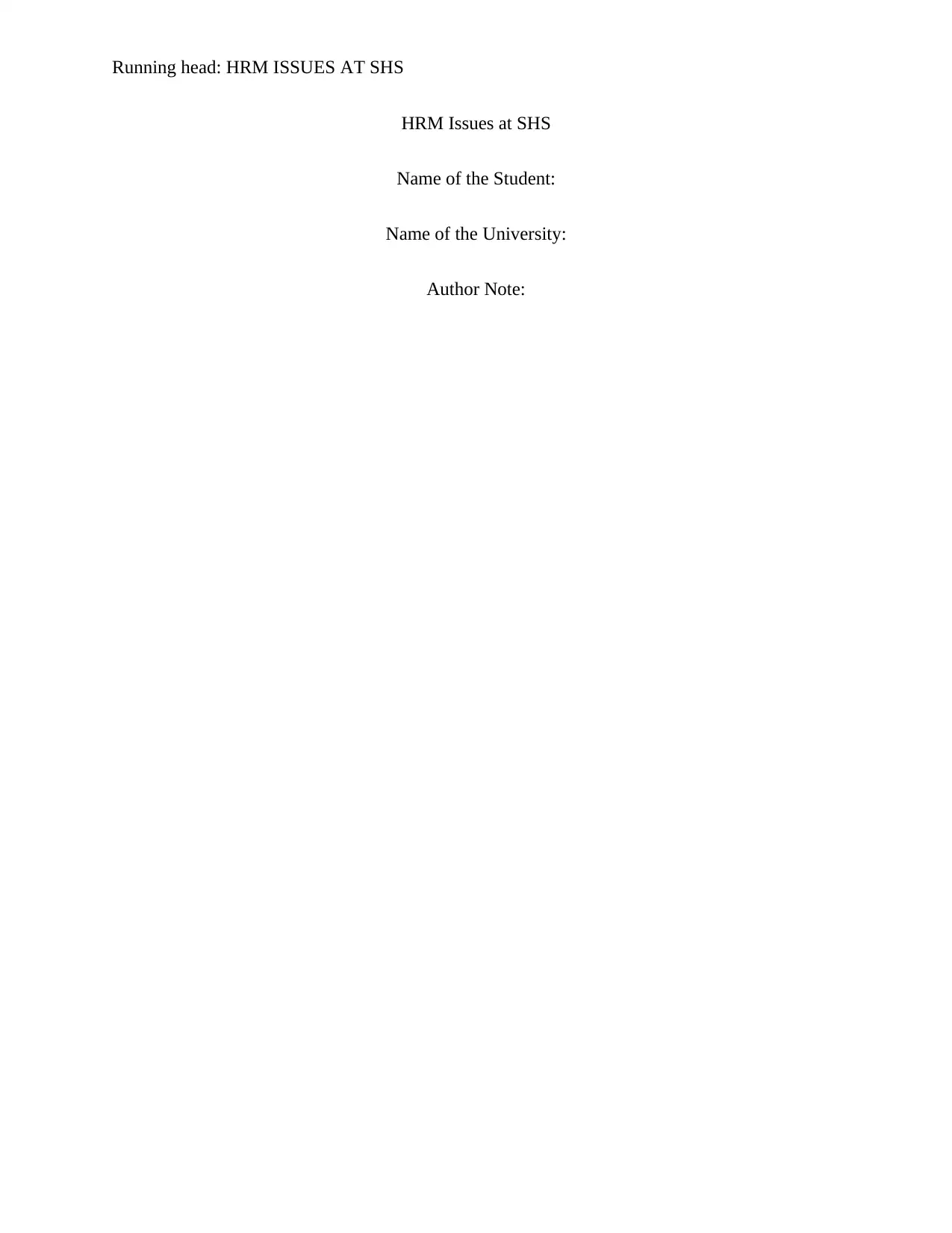
Running head: HRM ISSUES AT SHS
HRM Issues at SHS
Name of the Student:
Name of the University:
Author Note:
HRM Issues at SHS
Name of the Student:
Name of the University:
Author Note:
Secure Best Marks with AI Grader
Need help grading? Try our AI Grader for instant feedback on your assignments.
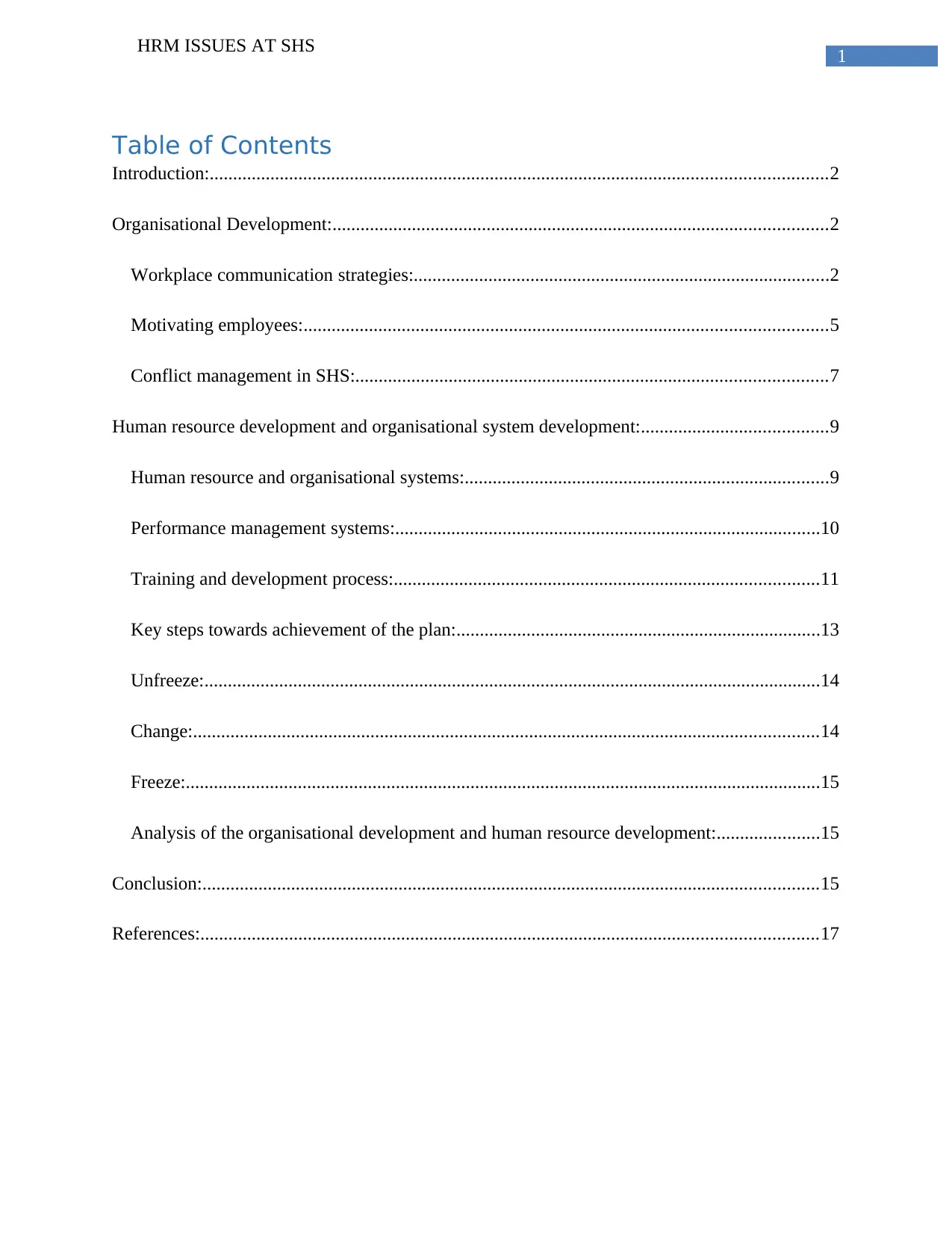
1
HRM ISSUES AT SHS
Table of Contents
Introduction:....................................................................................................................................2
Organisational Development:..........................................................................................................2
Workplace communication strategies:.........................................................................................2
Motivating employees:................................................................................................................5
Conflict management in SHS:.....................................................................................................7
Human resource development and organisational system development:........................................9
Human resource and organisational systems:..............................................................................9
Performance management systems:...........................................................................................10
Training and development process:...........................................................................................11
Key steps towards achievement of the plan:..............................................................................13
Unfreeze:....................................................................................................................................14
Change:......................................................................................................................................14
Freeze:........................................................................................................................................15
Analysis of the organisational development and human resource development:......................15
Conclusion:....................................................................................................................................15
References:....................................................................................................................................17
HRM ISSUES AT SHS
Table of Contents
Introduction:....................................................................................................................................2
Organisational Development:..........................................................................................................2
Workplace communication strategies:.........................................................................................2
Motivating employees:................................................................................................................5
Conflict management in SHS:.....................................................................................................7
Human resource development and organisational system development:........................................9
Human resource and organisational systems:..............................................................................9
Performance management systems:...........................................................................................10
Training and development process:...........................................................................................11
Key steps towards achievement of the plan:..............................................................................13
Unfreeze:....................................................................................................................................14
Change:......................................................................................................................................14
Freeze:........................................................................................................................................15
Analysis of the organisational development and human resource development:......................15
Conclusion:....................................................................................................................................15
References:....................................................................................................................................17
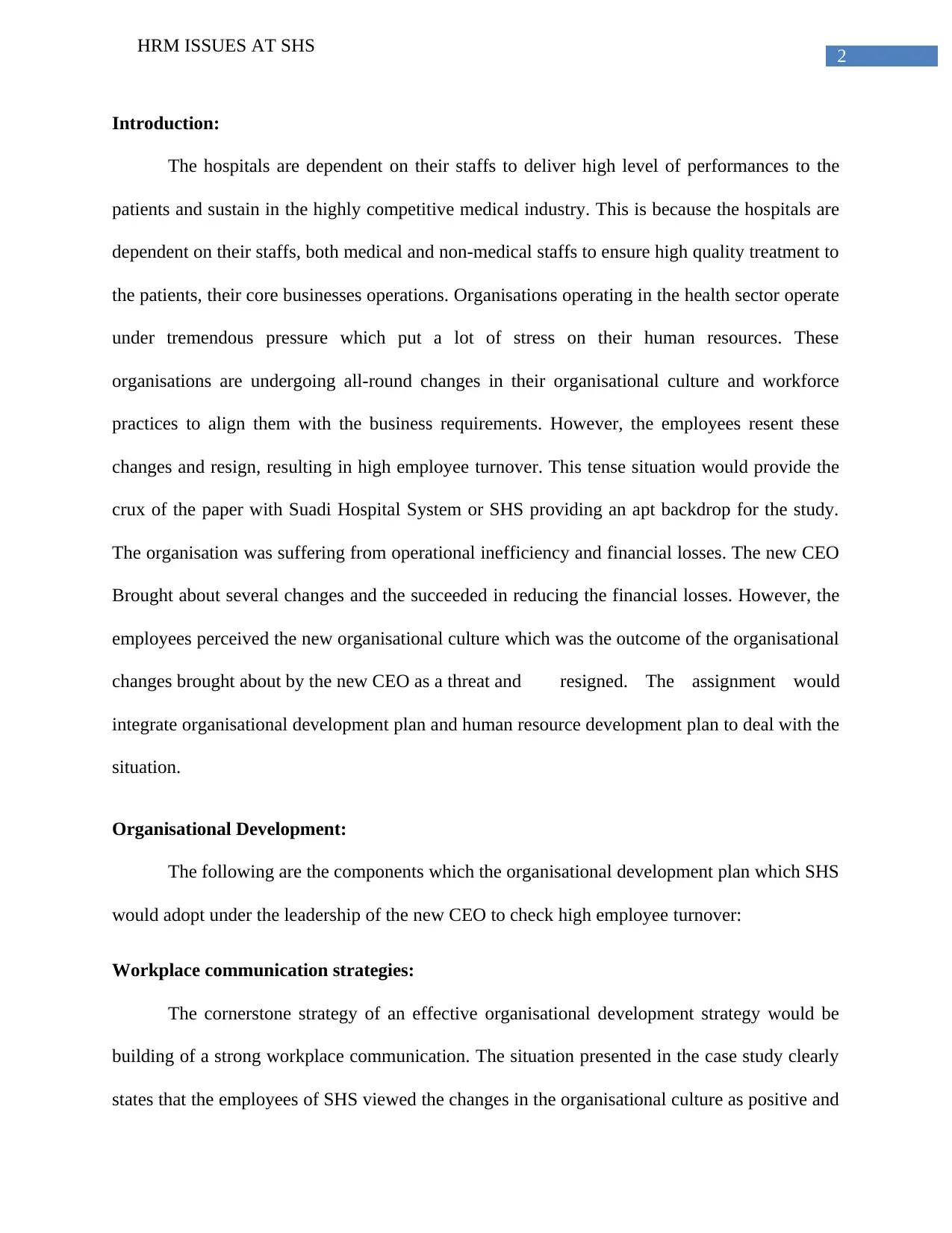
2
HRM ISSUES AT SHS
Introduction:
The hospitals are dependent on their staffs to deliver high level of performances to the
patients and sustain in the highly competitive medical industry. This is because the hospitals are
dependent on their staffs, both medical and non-medical staffs to ensure high quality treatment to
the patients, their core businesses operations. Organisations operating in the health sector operate
under tremendous pressure which put a lot of stress on their human resources. These
organisations are undergoing all-round changes in their organisational culture and workforce
practices to align them with the business requirements. However, the employees resent these
changes and resign, resulting in high employee turnover. This tense situation would provide the
crux of the paper with Suadi Hospital System or SHS providing an apt backdrop for the study.
The organisation was suffering from operational inefficiency and financial losses. The new CEO
Brought about several changes and the succeeded in reducing the financial losses. However, the
employees perceived the new organisational culture which was the outcome of the organisational
changes brought about by the new CEO as a threat and resigned. The assignment would
integrate organisational development plan and human resource development plan to deal with the
situation.
Organisational Development:
The following are the components which the organisational development plan which SHS
would adopt under the leadership of the new CEO to check high employee turnover:
Workplace communication strategies:
The cornerstone strategy of an effective organisational development strategy would be
building of a strong workplace communication. The situation presented in the case study clearly
states that the employees of SHS viewed the changes in the organisational culture as positive and
HRM ISSUES AT SHS
Introduction:
The hospitals are dependent on their staffs to deliver high level of performances to the
patients and sustain in the highly competitive medical industry. This is because the hospitals are
dependent on their staffs, both medical and non-medical staffs to ensure high quality treatment to
the patients, their core businesses operations. Organisations operating in the health sector operate
under tremendous pressure which put a lot of stress on their human resources. These
organisations are undergoing all-round changes in their organisational culture and workforce
practices to align them with the business requirements. However, the employees resent these
changes and resign, resulting in high employee turnover. This tense situation would provide the
crux of the paper with Suadi Hospital System or SHS providing an apt backdrop for the study.
The organisation was suffering from operational inefficiency and financial losses. The new CEO
Brought about several changes and the succeeded in reducing the financial losses. However, the
employees perceived the new organisational culture which was the outcome of the organisational
changes brought about by the new CEO as a threat and resigned. The assignment would
integrate organisational development plan and human resource development plan to deal with the
situation.
Organisational Development:
The following are the components which the organisational development plan which SHS
would adopt under the leadership of the new CEO to check high employee turnover:
Workplace communication strategies:
The cornerstone strategy of an effective organisational development strategy would be
building of a strong workplace communication. The situation presented in the case study clearly
states that the employees of SHS viewed the changes in the organisational culture as positive and
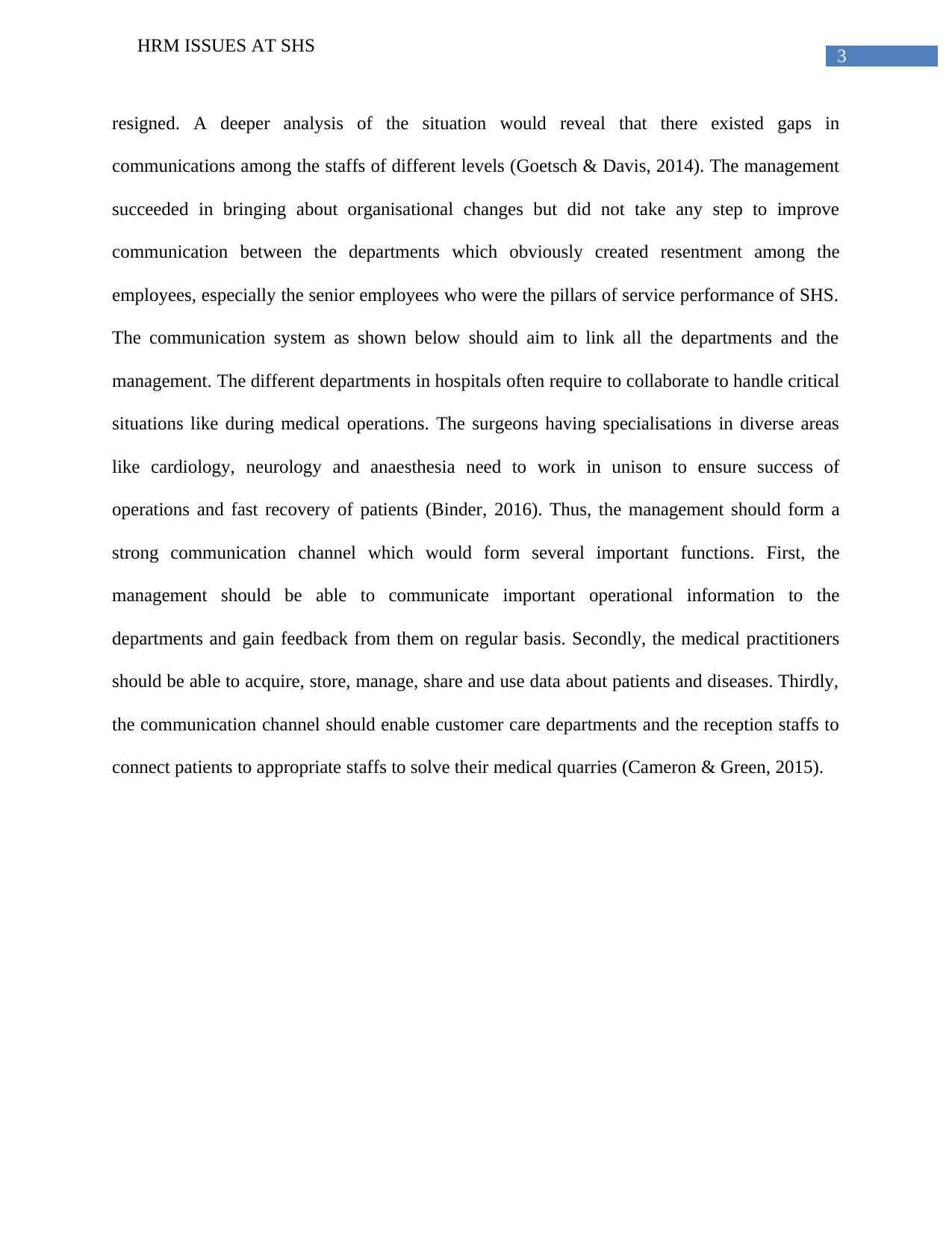
3
HRM ISSUES AT SHS
resigned. A deeper analysis of the situation would reveal that there existed gaps in
communications among the staffs of different levels (Goetsch & Davis, 2014). The management
succeeded in bringing about organisational changes but did not take any step to improve
communication between the departments which obviously created resentment among the
employees, especially the senior employees who were the pillars of service performance of SHS.
The communication system as shown below should aim to link all the departments and the
management. The different departments in hospitals often require to collaborate to handle critical
situations like during medical operations. The surgeons having specialisations in diverse areas
like cardiology, neurology and anaesthesia need to work in unison to ensure success of
operations and fast recovery of patients (Binder, 2016). Thus, the management should form a
strong communication channel which would form several important functions. First, the
management should be able to communicate important operational information to the
departments and gain feedback from them on regular basis. Secondly, the medical practitioners
should be able to acquire, store, manage, share and use data about patients and diseases. Thirdly,
the communication channel should enable customer care departments and the reception staffs to
connect patients to appropriate staffs to solve their medical quarries (Cameron & Green, 2015).
HRM ISSUES AT SHS
resigned. A deeper analysis of the situation would reveal that there existed gaps in
communications among the staffs of different levels (Goetsch & Davis, 2014). The management
succeeded in bringing about organisational changes but did not take any step to improve
communication between the departments which obviously created resentment among the
employees, especially the senior employees who were the pillars of service performance of SHS.
The communication system as shown below should aim to link all the departments and the
management. The different departments in hospitals often require to collaborate to handle critical
situations like during medical operations. The surgeons having specialisations in diverse areas
like cardiology, neurology and anaesthesia need to work in unison to ensure success of
operations and fast recovery of patients (Binder, 2016). Thus, the management should form a
strong communication channel which would form several important functions. First, the
management should be able to communicate important operational information to the
departments and gain feedback from them on regular basis. Secondly, the medical practitioners
should be able to acquire, store, manage, share and use data about patients and diseases. Thirdly,
the communication channel should enable customer care departments and the reception staffs to
connect patients to appropriate staffs to solve their medical quarries (Cameron & Green, 2015).
Secure Best Marks with AI Grader
Need help grading? Try our AI Grader for instant feedback on your assignments.
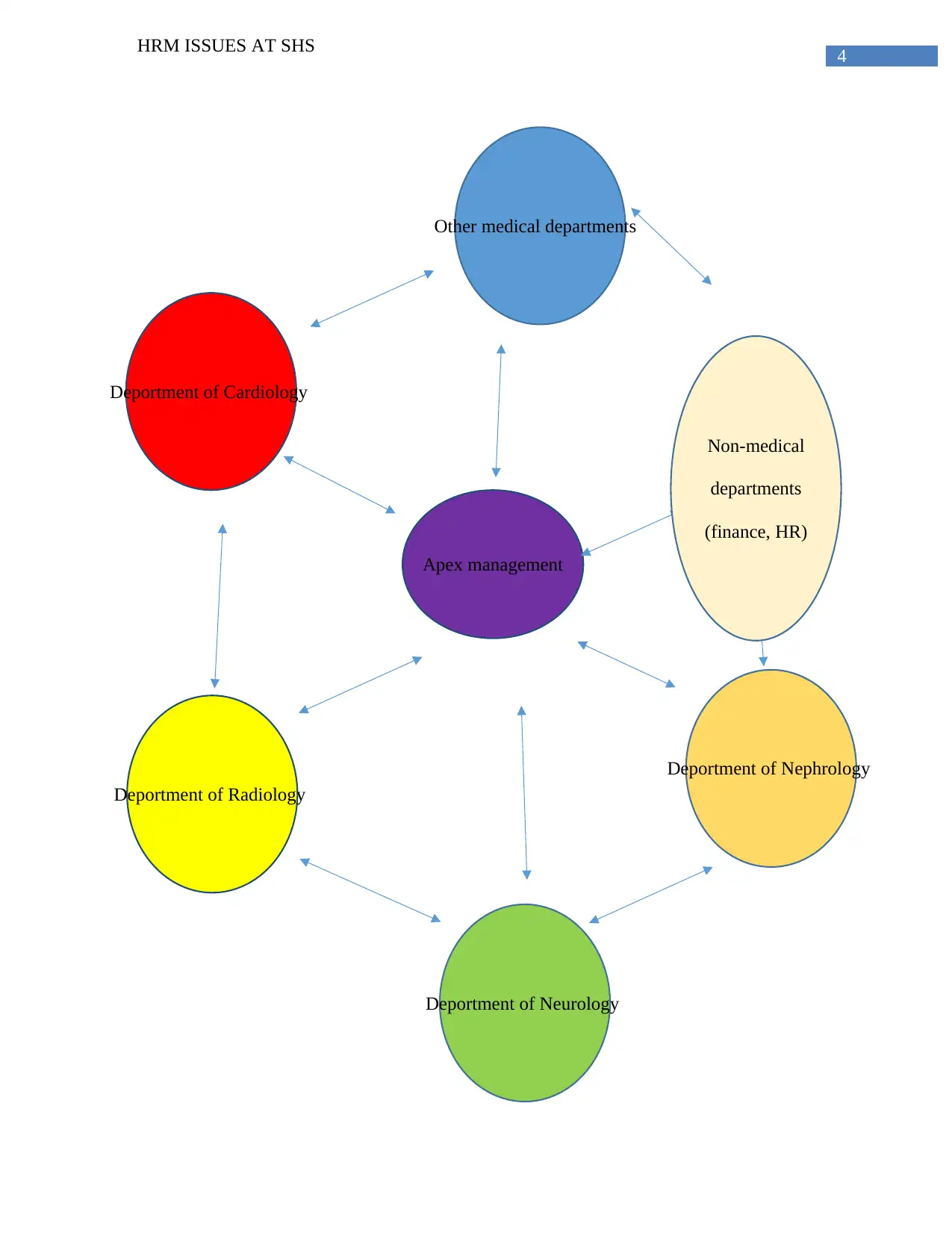
4
HRM ISSUES AT SHS
Apex management
Deportment of Cardiology
Deportment of Radiology
Deportment of Neurology
Deportment of Nephrology
Other medical departments
Non-medical
departments
(finance, HR)
HRM ISSUES AT SHS
Apex management
Deportment of Cardiology
Deportment of Radiology
Deportment of Neurology
Deportment of Nephrology
Other medical departments
Non-medical
departments
(finance, HR)
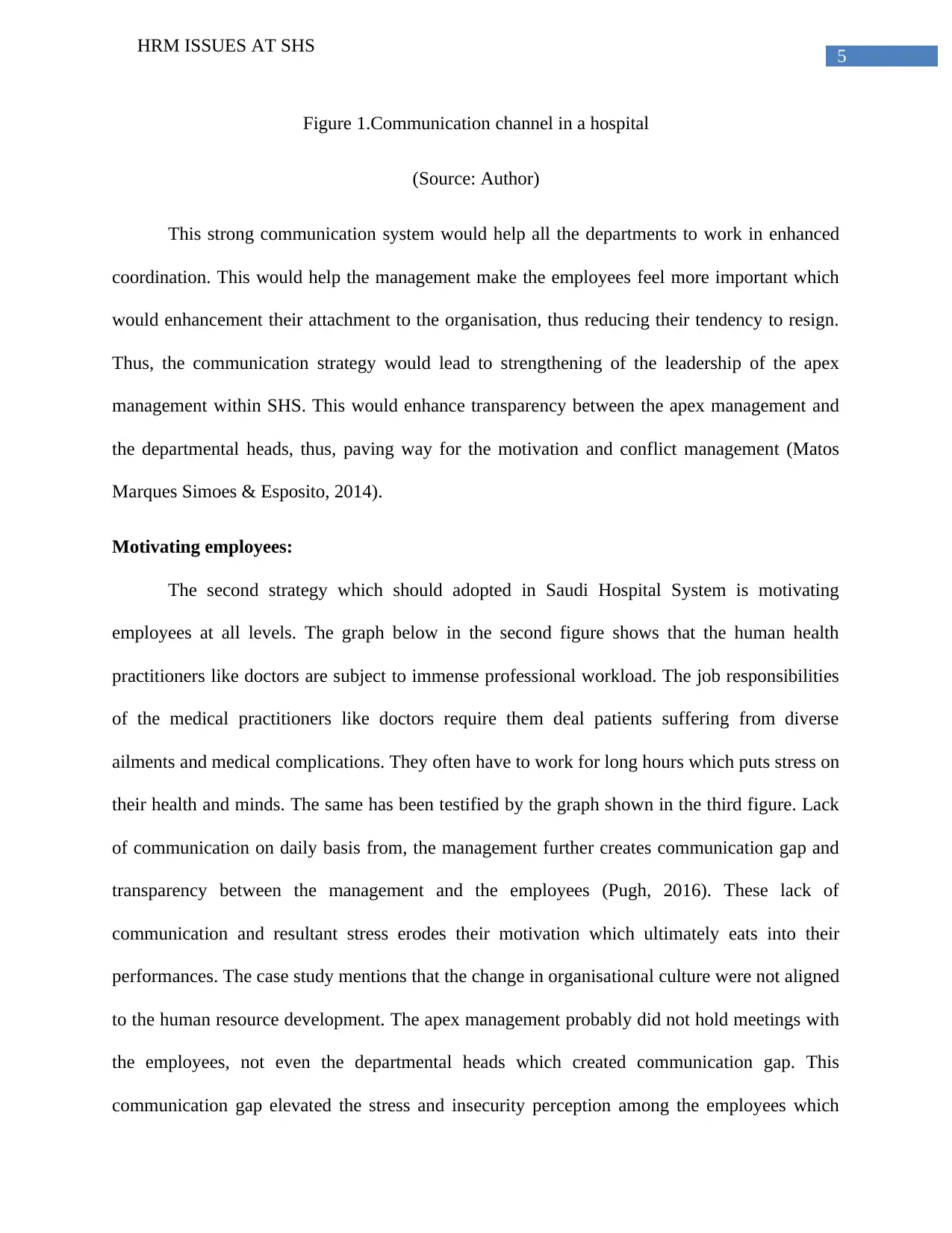
5
HRM ISSUES AT SHS
Figure 1.Communication channel in a hospital
(Source: Author)
This strong communication system would help all the departments to work in enhanced
coordination. This would help the management make the employees feel more important which
would enhancement their attachment to the organisation, thus reducing their tendency to resign.
Thus, the communication strategy would lead to strengthening of the leadership of the apex
management within SHS. This would enhance transparency between the apex management and
the departmental heads, thus, paving way for the motivation and conflict management (Matos
Marques Simoes & Esposito, 2014).
Motivating employees:
The second strategy which should adopted in Saudi Hospital System is motivating
employees at all levels. The graph below in the second figure shows that the human health
practitioners like doctors are subject to immense professional workload. The job responsibilities
of the medical practitioners like doctors require them deal patients suffering from diverse
ailments and medical complications. They often have to work for long hours which puts stress on
their health and minds. The same has been testified by the graph shown in the third figure. Lack
of communication on daily basis from, the management further creates communication gap and
transparency between the management and the employees (Pugh, 2016). These lack of
communication and resultant stress erodes their motivation which ultimately eats into their
performances. The case study mentions that the change in organisational culture were not aligned
to the human resource development. The apex management probably did not hold meetings with
the employees, not even the departmental heads which created communication gap. This
communication gap elevated the stress and insecurity perception among the employees which
HRM ISSUES AT SHS
Figure 1.Communication channel in a hospital
(Source: Author)
This strong communication system would help all the departments to work in enhanced
coordination. This would help the management make the employees feel more important which
would enhancement their attachment to the organisation, thus reducing their tendency to resign.
Thus, the communication strategy would lead to strengthening of the leadership of the apex
management within SHS. This would enhance transparency between the apex management and
the departmental heads, thus, paving way for the motivation and conflict management (Matos
Marques Simoes & Esposito, 2014).
Motivating employees:
The second strategy which should adopted in Saudi Hospital System is motivating
employees at all levels. The graph below in the second figure shows that the human health
practitioners like doctors are subject to immense professional workload. The job responsibilities
of the medical practitioners like doctors require them deal patients suffering from diverse
ailments and medical complications. They often have to work for long hours which puts stress on
their health and minds. The same has been testified by the graph shown in the third figure. Lack
of communication on daily basis from, the management further creates communication gap and
transparency between the management and the employees (Pugh, 2016). These lack of
communication and resultant stress erodes their motivation which ultimately eats into their
performances. The case study mentions that the change in organisational culture were not aligned
to the human resource development. The apex management probably did not hold meetings with
the employees, not even the departmental heads which created communication gap. This
communication gap elevated the stress and insecurity perception among the employees which
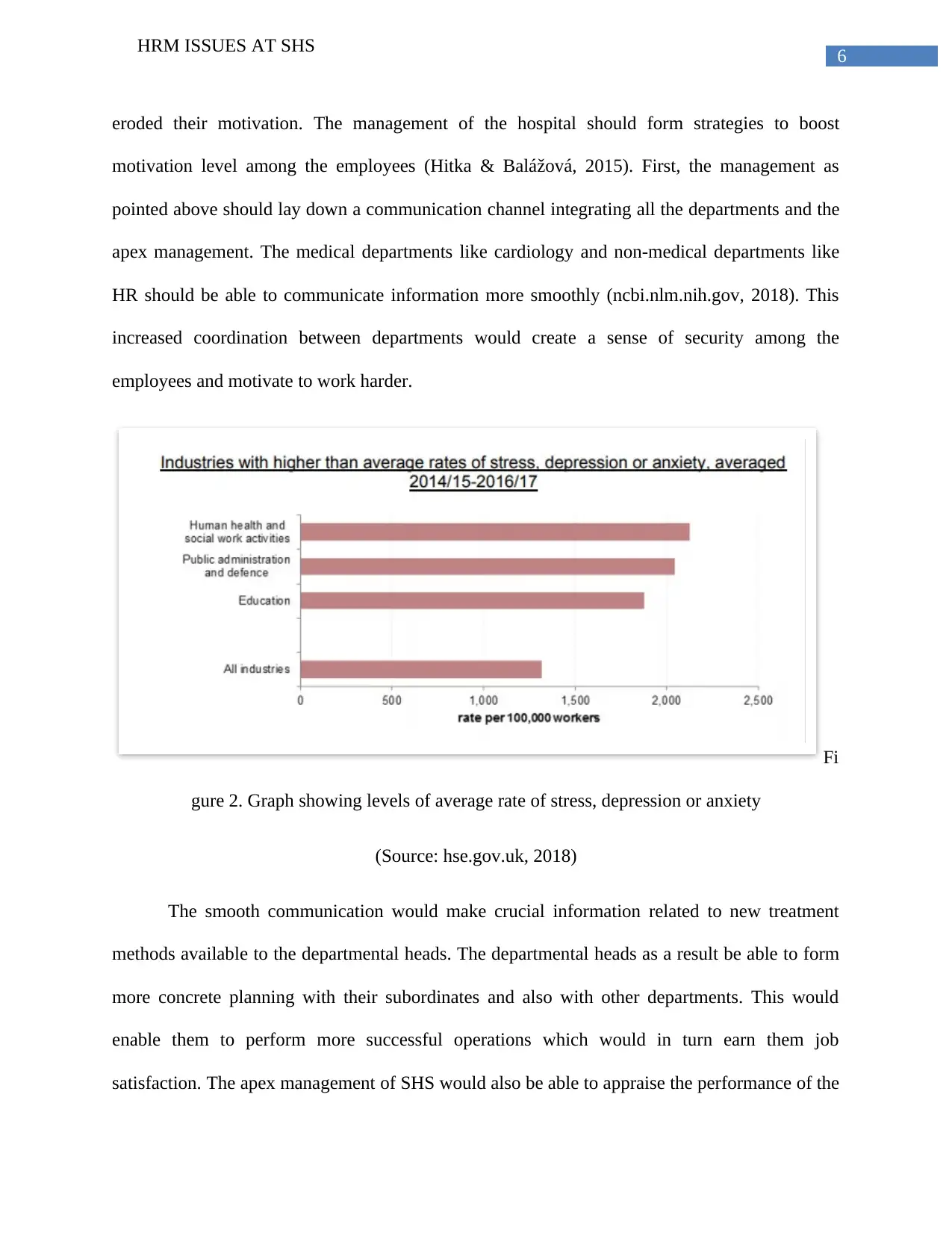
6
HRM ISSUES AT SHS
eroded their motivation. The management of the hospital should form strategies to boost
motivation level among the employees (Hitka & Balážová, 2015). First, the management as
pointed above should lay down a communication channel integrating all the departments and the
apex management. The medical departments like cardiology and non-medical departments like
HR should be able to communicate information more smoothly (ncbi.nlm.nih.gov, 2018). This
increased coordination between departments would create a sense of security among the
employees and motivate to work harder.
Fi
gure 2. Graph showing levels of average rate of stress, depression or anxiety
(Source: hse.gov.uk, 2018)
The smooth communication would make crucial information related to new treatment
methods available to the departmental heads. The departmental heads as a result be able to form
more concrete planning with their subordinates and also with other departments. This would
enable them to perform more successful operations which would in turn earn them job
satisfaction. The apex management of SHS would also be able to appraise the performance of the
HRM ISSUES AT SHS
eroded their motivation. The management of the hospital should form strategies to boost
motivation level among the employees (Hitka & Balážová, 2015). First, the management as
pointed above should lay down a communication channel integrating all the departments and the
apex management. The medical departments like cardiology and non-medical departments like
HR should be able to communicate information more smoothly (ncbi.nlm.nih.gov, 2018). This
increased coordination between departments would create a sense of security among the
employees and motivate to work harder.
Fi
gure 2. Graph showing levels of average rate of stress, depression or anxiety
(Source: hse.gov.uk, 2018)
The smooth communication would make crucial information related to new treatment
methods available to the departmental heads. The departmental heads as a result be able to form
more concrete planning with their subordinates and also with other departments. This would
enable them to perform more successful operations which would in turn earn them job
satisfaction. The apex management of SHS would also be able to appraise the performance of the
Paraphrase This Document
Need a fresh take? Get an instant paraphrase of this document with our AI Paraphraser
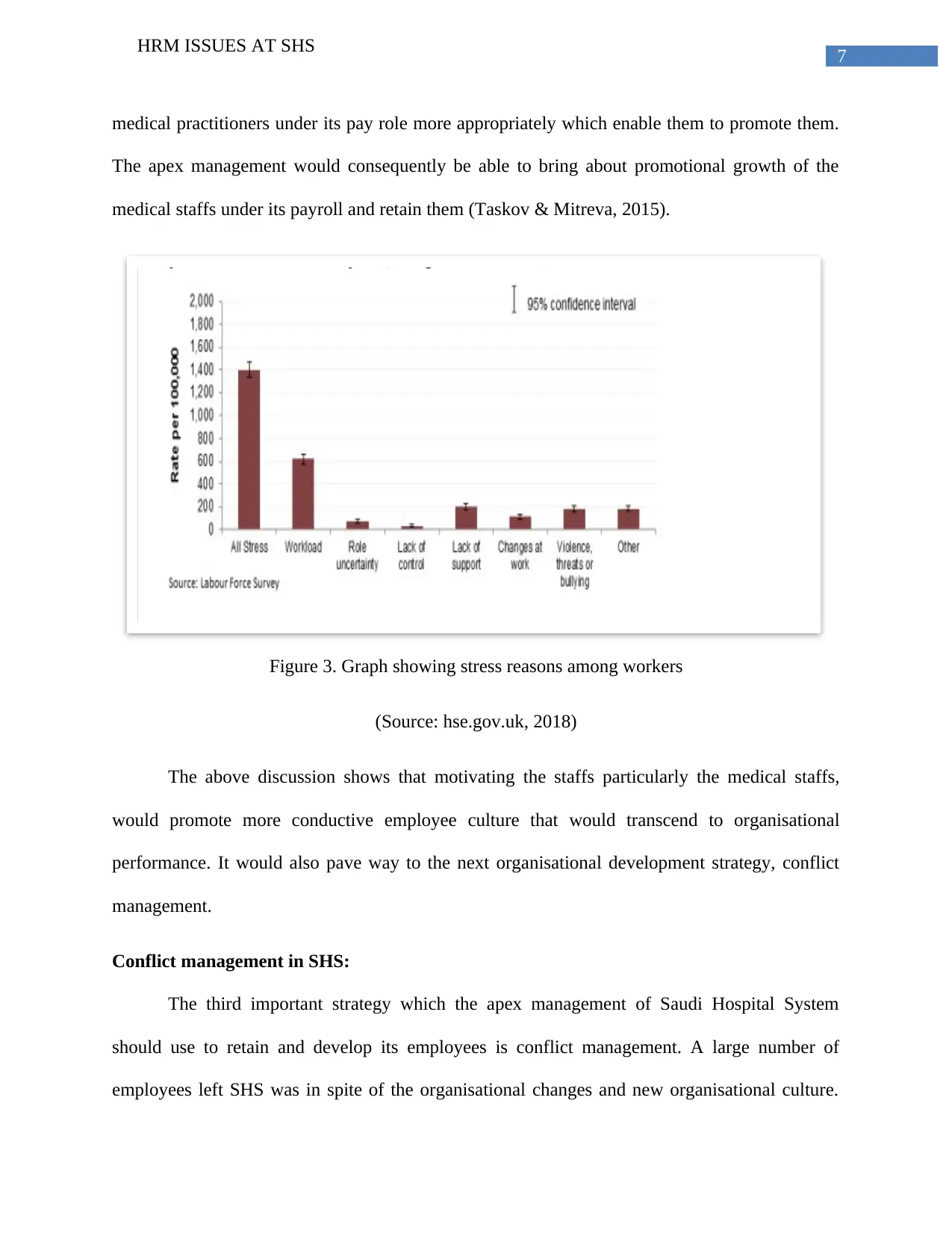
7
HRM ISSUES AT SHS
medical practitioners under its pay role more appropriately which enable them to promote them.
The apex management would consequently be able to bring about promotional growth of the
medical staffs under its payroll and retain them (Taskov & Mitreva, 2015).
Figure 3. Graph showing stress reasons among workers
(Source: hse.gov.uk, 2018)
The above discussion shows that motivating the staffs particularly the medical staffs,
would promote more conductive employee culture that would transcend to organisational
performance. It would also pave way to the next organisational development strategy, conflict
management.
Conflict management in SHS:
The third important strategy which the apex management of Saudi Hospital System
should use to retain and develop its employees is conflict management. A large number of
employees left SHS was in spite of the organisational changes and new organisational culture.
HRM ISSUES AT SHS
medical practitioners under its pay role more appropriately which enable them to promote them.
The apex management would consequently be able to bring about promotional growth of the
medical staffs under its payroll and retain them (Taskov & Mitreva, 2015).
Figure 3. Graph showing stress reasons among workers
(Source: hse.gov.uk, 2018)
The above discussion shows that motivating the staffs particularly the medical staffs,
would promote more conductive employee culture that would transcend to organisational
performance. It would also pave way to the next organisational development strategy, conflict
management.
Conflict management in SHS:
The third important strategy which the apex management of Saudi Hospital System
should use to retain and develop its employees is conflict management. A large number of
employees left SHS was in spite of the organisational changes and new organisational culture.
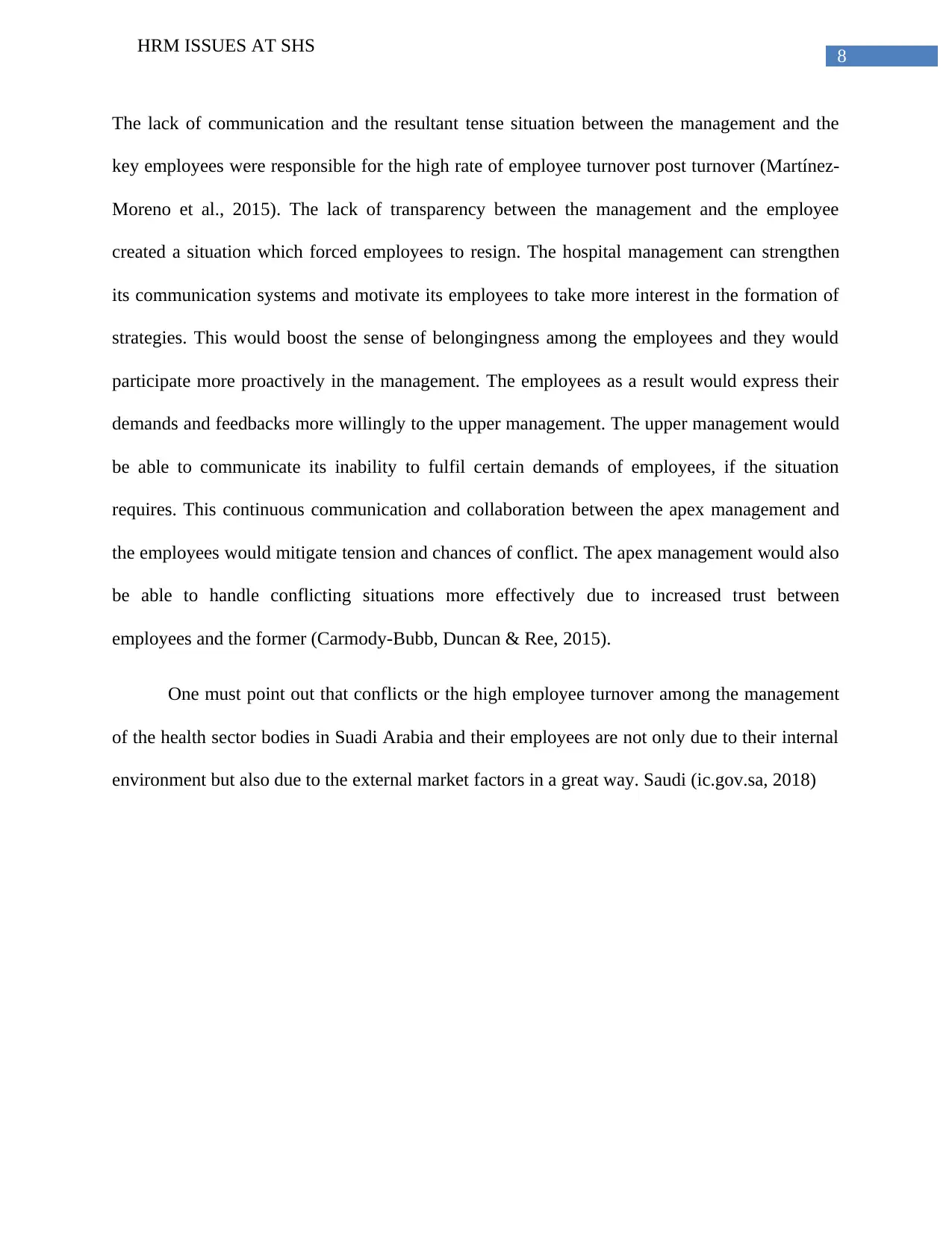
8
HRM ISSUES AT SHS
The lack of communication and the resultant tense situation between the management and the
key employees were responsible for the high rate of employee turnover post turnover (Martínez-
Moreno et al., 2015). The lack of transparency between the management and the employee
created a situation which forced employees to resign. The hospital management can strengthen
its communication systems and motivate its employees to take more interest in the formation of
strategies. This would boost the sense of belongingness among the employees and they would
participate more proactively in the management. The employees as a result would express their
demands and feedbacks more willingly to the upper management. The upper management would
be able to communicate its inability to fulfil certain demands of employees, if the situation
requires. This continuous communication and collaboration between the apex management and
the employees would mitigate tension and chances of conflict. The apex management would also
be able to handle conflicting situations more effectively due to increased trust between
employees and the former (Carmody-Bubb, Duncan & Ree, 2015).
One must point out that conflicts or the high employee turnover among the management
of the health sector bodies in Suadi Arabia and their employees are not only due to their internal
environment but also due to the external market factors in a great way. Saudi (ic.gov.sa, 2018)
HRM ISSUES AT SHS
The lack of communication and the resultant tense situation between the management and the
key employees were responsible for the high rate of employee turnover post turnover (Martínez-
Moreno et al., 2015). The lack of transparency between the management and the employee
created a situation which forced employees to resign. The hospital management can strengthen
its communication systems and motivate its employees to take more interest in the formation of
strategies. This would boost the sense of belongingness among the employees and they would
participate more proactively in the management. The employees as a result would express their
demands and feedbacks more willingly to the upper management. The upper management would
be able to communicate its inability to fulfil certain demands of employees, if the situation
requires. This continuous communication and collaboration between the apex management and
the employees would mitigate tension and chances of conflict. The apex management would also
be able to handle conflicting situations more effectively due to increased trust between
employees and the former (Carmody-Bubb, Duncan & Ree, 2015).
One must point out that conflicts or the high employee turnover among the management
of the health sector bodies in Suadi Arabia and their employees are not only due to their internal
environment but also due to the external market factors in a great way. Saudi (ic.gov.sa, 2018)
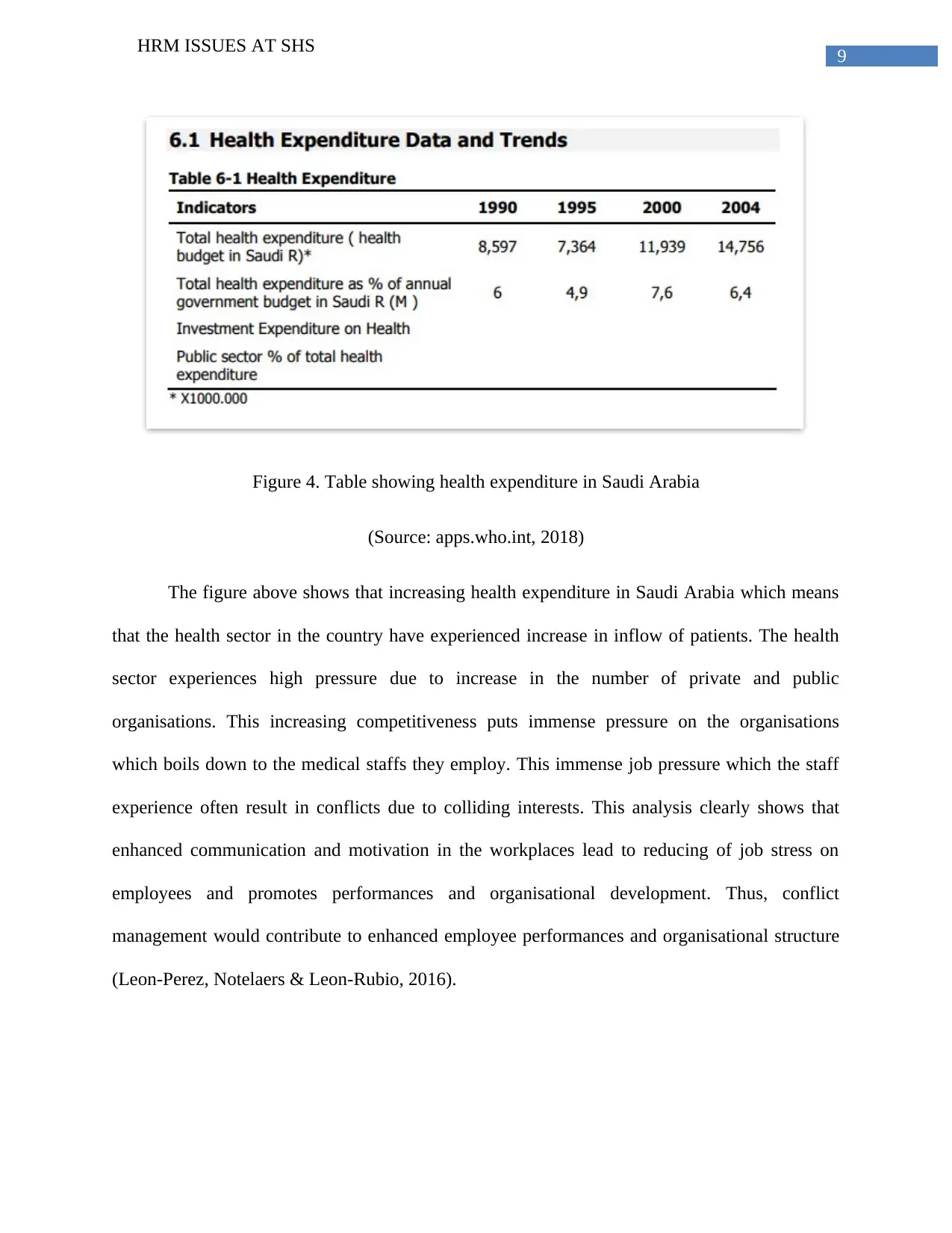
9
HRM ISSUES AT SHS
Figure 4. Table showing health expenditure in Saudi Arabia
(Source: apps.who.int, 2018)
The figure above shows that increasing health expenditure in Saudi Arabia which means
that the health sector in the country have experienced increase in inflow of patients. The health
sector experiences high pressure due to increase in the number of private and public
organisations. This increasing competitiveness puts immense pressure on the organisations
which boils down to the medical staffs they employ. This immense job pressure which the staff
experience often result in conflicts due to colliding interests. This analysis clearly shows that
enhanced communication and motivation in the workplaces lead to reducing of job stress on
employees and promotes performances and organisational development. Thus, conflict
management would contribute to enhanced employee performances and organisational structure
(Leon-Perez, Notelaers & Leon-Rubio, 2016).
HRM ISSUES AT SHS
Figure 4. Table showing health expenditure in Saudi Arabia
(Source: apps.who.int, 2018)
The figure above shows that increasing health expenditure in Saudi Arabia which means
that the health sector in the country have experienced increase in inflow of patients. The health
sector experiences high pressure due to increase in the number of private and public
organisations. This increasing competitiveness puts immense pressure on the organisations
which boils down to the medical staffs they employ. This immense job pressure which the staff
experience often result in conflicts due to colliding interests. This analysis clearly shows that
enhanced communication and motivation in the workplaces lead to reducing of job stress on
employees and promotes performances and organisational development. Thus, conflict
management would contribute to enhanced employee performances and organisational structure
(Leon-Perez, Notelaers & Leon-Rubio, 2016).
Secure Best Marks with AI Grader
Need help grading? Try our AI Grader for instant feedback on your assignments.
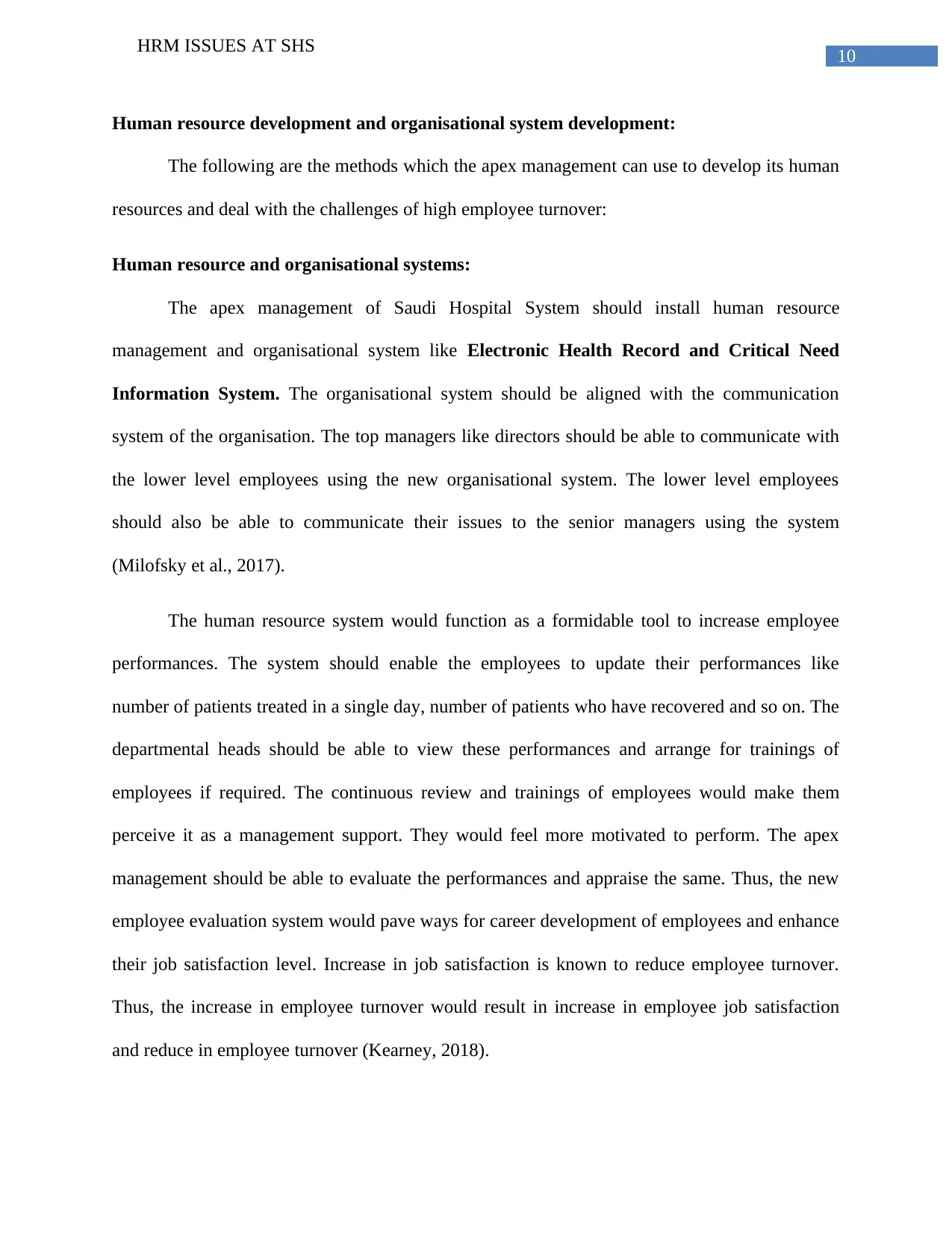
10
HRM ISSUES AT SHS
Human resource development and organisational system development:
The following are the methods which the apex management can use to develop its human
resources and deal with the challenges of high employee turnover:
Human resource and organisational systems:
The apex management of Saudi Hospital System should install human resource
management and organisational system like Electronic Health Record and Critical Need
Information System. The organisational system should be aligned with the communication
system of the organisation. The top managers like directors should be able to communicate with
the lower level employees using the new organisational system. The lower level employees
should also be able to communicate their issues to the senior managers using the system
(Milofsky et al., 2017).
The human resource system would function as a formidable tool to increase employee
performances. The system should enable the employees to update their performances like
number of patients treated in a single day, number of patients who have recovered and so on. The
departmental heads should be able to view these performances and arrange for trainings of
employees if required. The continuous review and trainings of employees would make them
perceive it as a management support. They would feel more motivated to perform. The apex
management should be able to evaluate the performances and appraise the same. Thus, the new
employee evaluation system would pave ways for career development of employees and enhance
their job satisfaction level. Increase in job satisfaction is known to reduce employee turnover.
Thus, the increase in employee turnover would result in increase in employee job satisfaction
and reduce in employee turnover (Kearney, 2018).
HRM ISSUES AT SHS
Human resource development and organisational system development:
The following are the methods which the apex management can use to develop its human
resources and deal with the challenges of high employee turnover:
Human resource and organisational systems:
The apex management of Saudi Hospital System should install human resource
management and organisational system like Electronic Health Record and Critical Need
Information System. The organisational system should be aligned with the communication
system of the organisation. The top managers like directors should be able to communicate with
the lower level employees using the new organisational system. The lower level employees
should also be able to communicate their issues to the senior managers using the system
(Milofsky et al., 2017).
The human resource system would function as a formidable tool to increase employee
performances. The system should enable the employees to update their performances like
number of patients treated in a single day, number of patients who have recovered and so on. The
departmental heads should be able to view these performances and arrange for trainings of
employees if required. The continuous review and trainings of employees would make them
perceive it as a management support. They would feel more motivated to perform. The apex
management should be able to evaluate the performances and appraise the same. Thus, the new
employee evaluation system would pave ways for career development of employees and enhance
their job satisfaction level. Increase in job satisfaction is known to reduce employee turnover.
Thus, the increase in employee turnover would result in increase in employee job satisfaction
and reduce in employee turnover (Kearney, 2018).
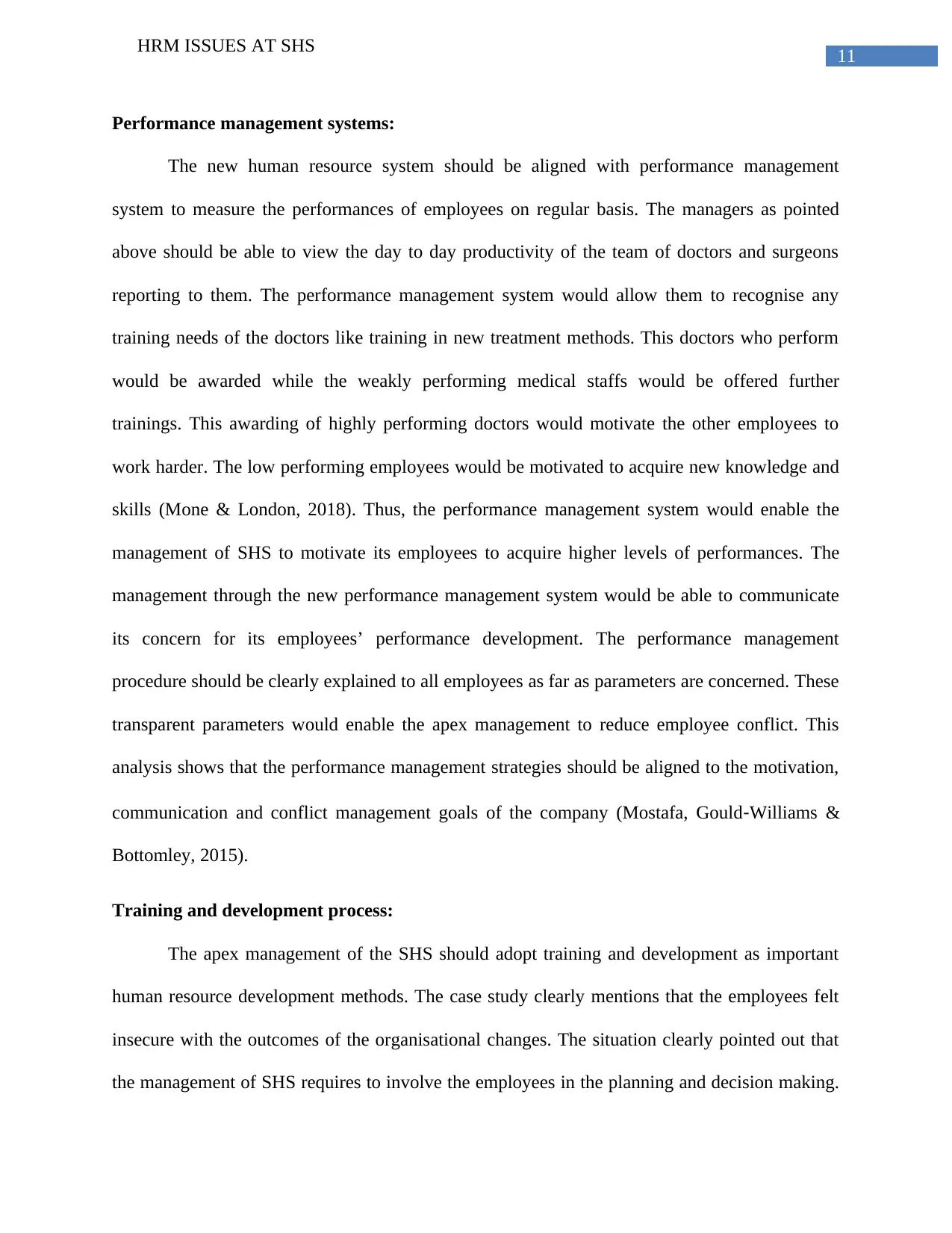
11
HRM ISSUES AT SHS
Performance management systems:
The new human resource system should be aligned with performance management
system to measure the performances of employees on regular basis. The managers as pointed
above should be able to view the day to day productivity of the team of doctors and surgeons
reporting to them. The performance management system would allow them to recognise any
training needs of the doctors like training in new treatment methods. This doctors who perform
would be awarded while the weakly performing medical staffs would be offered further
trainings. This awarding of highly performing doctors would motivate the other employees to
work harder. The low performing employees would be motivated to acquire new knowledge and
skills (Mone & London, 2018). Thus, the performance management system would enable the
management of SHS to motivate its employees to acquire higher levels of performances. The
management through the new performance management system would be able to communicate
its concern for its employees’ performance development. The performance management
procedure should be clearly explained to all employees as far as parameters are concerned. These
transparent parameters would enable the apex management to reduce employee conflict. This
analysis shows that the performance management strategies should be aligned to the motivation,
communication and conflict management goals of the company (Mostafa, Gould‐Williams &
Bottomley, 2015).
Training and development process:
The apex management of the SHS should adopt training and development as important
human resource development methods. The case study clearly mentions that the employees felt
insecure with the outcomes of the organisational changes. The situation clearly pointed out that
the management of SHS requires to involve the employees in the planning and decision making.
HRM ISSUES AT SHS
Performance management systems:
The new human resource system should be aligned with performance management
system to measure the performances of employees on regular basis. The managers as pointed
above should be able to view the day to day productivity of the team of doctors and surgeons
reporting to them. The performance management system would allow them to recognise any
training needs of the doctors like training in new treatment methods. This doctors who perform
would be awarded while the weakly performing medical staffs would be offered further
trainings. This awarding of highly performing doctors would motivate the other employees to
work harder. The low performing employees would be motivated to acquire new knowledge and
skills (Mone & London, 2018). Thus, the performance management system would enable the
management of SHS to motivate its employees to acquire higher levels of performances. The
management through the new performance management system would be able to communicate
its concern for its employees’ performance development. The performance management
procedure should be clearly explained to all employees as far as parameters are concerned. These
transparent parameters would enable the apex management to reduce employee conflict. This
analysis shows that the performance management strategies should be aligned to the motivation,
communication and conflict management goals of the company (Mostafa, Gould‐Williams &
Bottomley, 2015).
Training and development process:
The apex management of the SHS should adopt training and development as important
human resource development methods. The case study clearly mentions that the employees felt
insecure with the outcomes of the organisational changes. The situation clearly pointed out that
the management of SHS requires to involve the employees in the planning and decision making.
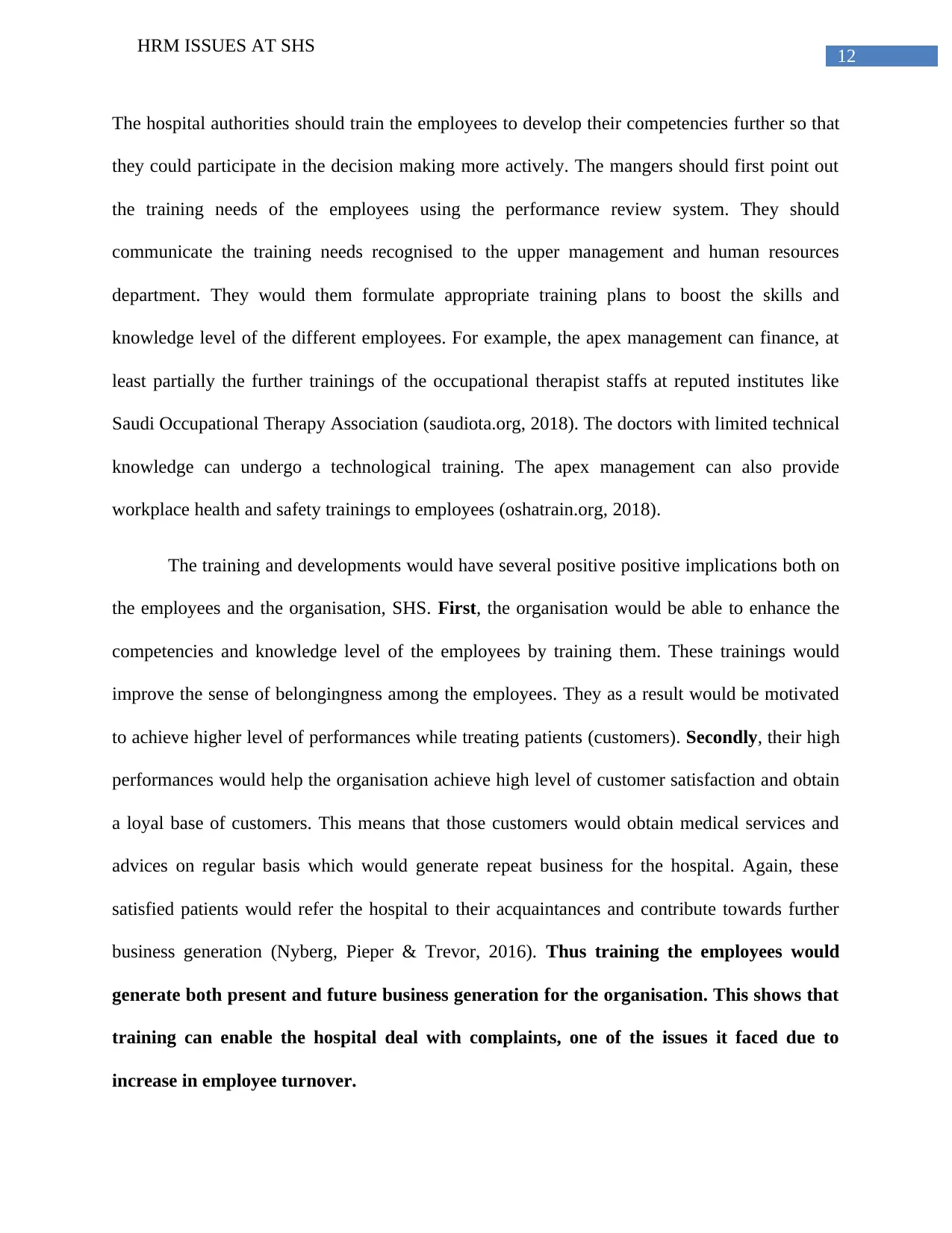
12
HRM ISSUES AT SHS
The hospital authorities should train the employees to develop their competencies further so that
they could participate in the decision making more actively. The mangers should first point out
the training needs of the employees using the performance review system. They should
communicate the training needs recognised to the upper management and human resources
department. They would them formulate appropriate training plans to boost the skills and
knowledge level of the different employees. For example, the apex management can finance, at
least partially the further trainings of the occupational therapist staffs at reputed institutes like
Saudi Occupational Therapy Association (saudiota.org, 2018). The doctors with limited technical
knowledge can undergo a technological training. The apex management can also provide
workplace health and safety trainings to employees (oshatrain.org, 2018).
The training and developments would have several positive positive implications both on
the employees and the organisation, SHS. First, the organisation would be able to enhance the
competencies and knowledge level of the employees by training them. These trainings would
improve the sense of belongingness among the employees. They as a result would be motivated
to achieve higher level of performances while treating patients (customers). Secondly, their high
performances would help the organisation achieve high level of customer satisfaction and obtain
a loyal base of customers. This means that those customers would obtain medical services and
advices on regular basis which would generate repeat business for the hospital. Again, these
satisfied patients would refer the hospital to their acquaintances and contribute towards further
business generation (Nyberg, Pieper & Trevor, 2016). Thus training the employees would
generate both present and future business generation for the organisation. This shows that
training can enable the hospital deal with complaints, one of the issues it faced due to
increase in employee turnover.
HRM ISSUES AT SHS
The hospital authorities should train the employees to develop their competencies further so that
they could participate in the decision making more actively. The mangers should first point out
the training needs of the employees using the performance review system. They should
communicate the training needs recognised to the upper management and human resources
department. They would them formulate appropriate training plans to boost the skills and
knowledge level of the different employees. For example, the apex management can finance, at
least partially the further trainings of the occupational therapist staffs at reputed institutes like
Saudi Occupational Therapy Association (saudiota.org, 2018). The doctors with limited technical
knowledge can undergo a technological training. The apex management can also provide
workplace health and safety trainings to employees (oshatrain.org, 2018).
The training and developments would have several positive positive implications both on
the employees and the organisation, SHS. First, the organisation would be able to enhance the
competencies and knowledge level of the employees by training them. These trainings would
improve the sense of belongingness among the employees. They as a result would be motivated
to achieve higher level of performances while treating patients (customers). Secondly, their high
performances would help the organisation achieve high level of customer satisfaction and obtain
a loyal base of customers. This means that those customers would obtain medical services and
advices on regular basis which would generate repeat business for the hospital. Again, these
satisfied patients would refer the hospital to their acquaintances and contribute towards further
business generation (Nyberg, Pieper & Trevor, 2016). Thus training the employees would
generate both present and future business generation for the organisation. This shows that
training can enable the hospital deal with complaints, one of the issues it faced due to
increase in employee turnover.
Paraphrase This Document
Need a fresh take? Get an instant paraphrase of this document with our AI Paraphraser
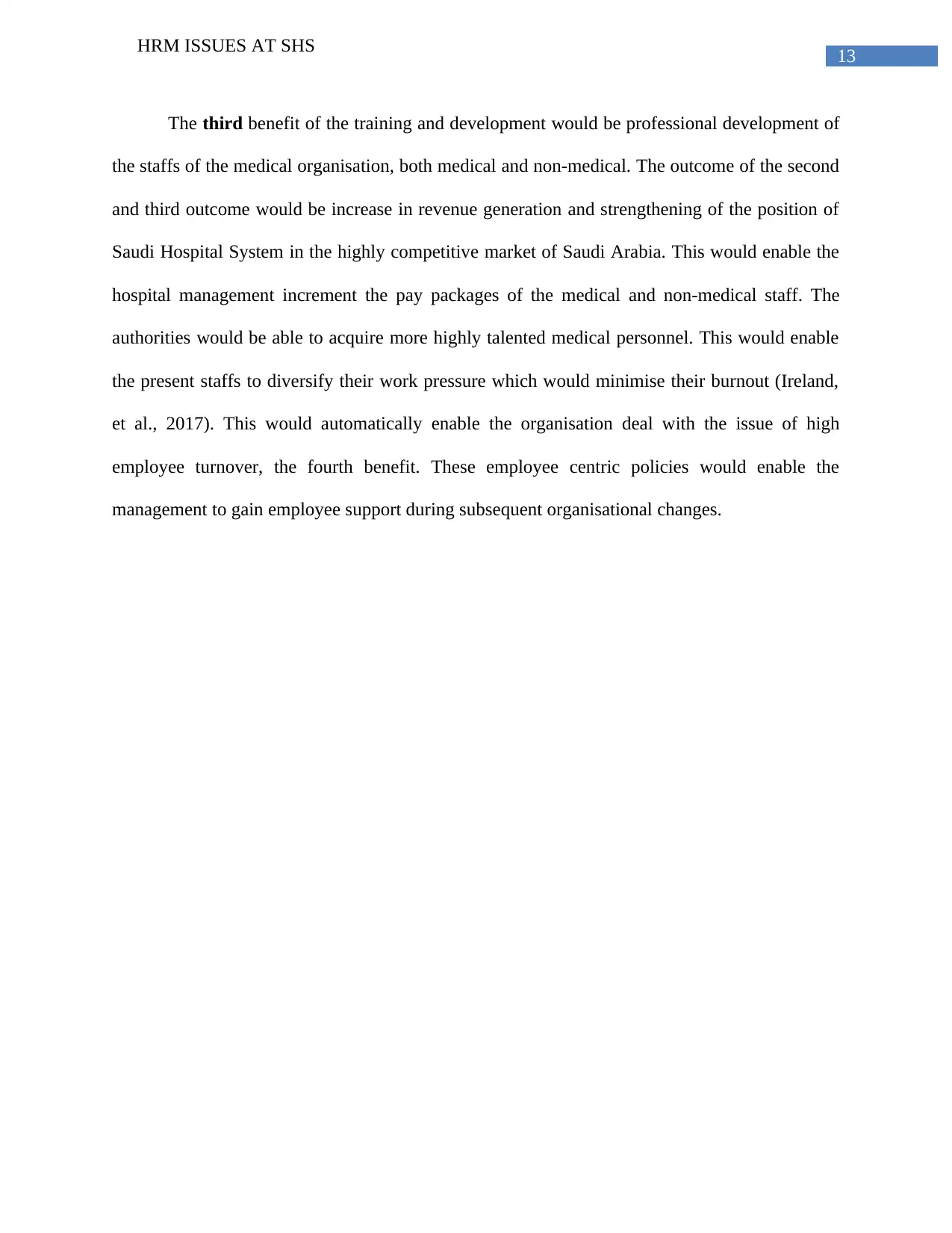
13
HRM ISSUES AT SHS
The third benefit of the training and development would be professional development of
the staffs of the medical organisation, both medical and non-medical. The outcome of the second
and third outcome would be increase in revenue generation and strengthening of the position of
Saudi Hospital System in the highly competitive market of Saudi Arabia. This would enable the
hospital management increment the pay packages of the medical and non-medical staff. The
authorities would be able to acquire more highly talented medical personnel. This would enable
the present staffs to diversify their work pressure which would minimise their burnout (Ireland,
et al., 2017). This would automatically enable the organisation deal with the issue of high
employee turnover, the fourth benefit. These employee centric policies would enable the
management to gain employee support during subsequent organisational changes.
HRM ISSUES AT SHS
The third benefit of the training and development would be professional development of
the staffs of the medical organisation, both medical and non-medical. The outcome of the second
and third outcome would be increase in revenue generation and strengthening of the position of
Saudi Hospital System in the highly competitive market of Saudi Arabia. This would enable the
hospital management increment the pay packages of the medical and non-medical staff. The
authorities would be able to acquire more highly talented medical personnel. This would enable
the present staffs to diversify their work pressure which would minimise their burnout (Ireland,
et al., 2017). This would automatically enable the organisation deal with the issue of high
employee turnover, the fourth benefit. These employee centric policies would enable the
management to gain employee support during subsequent organisational changes.
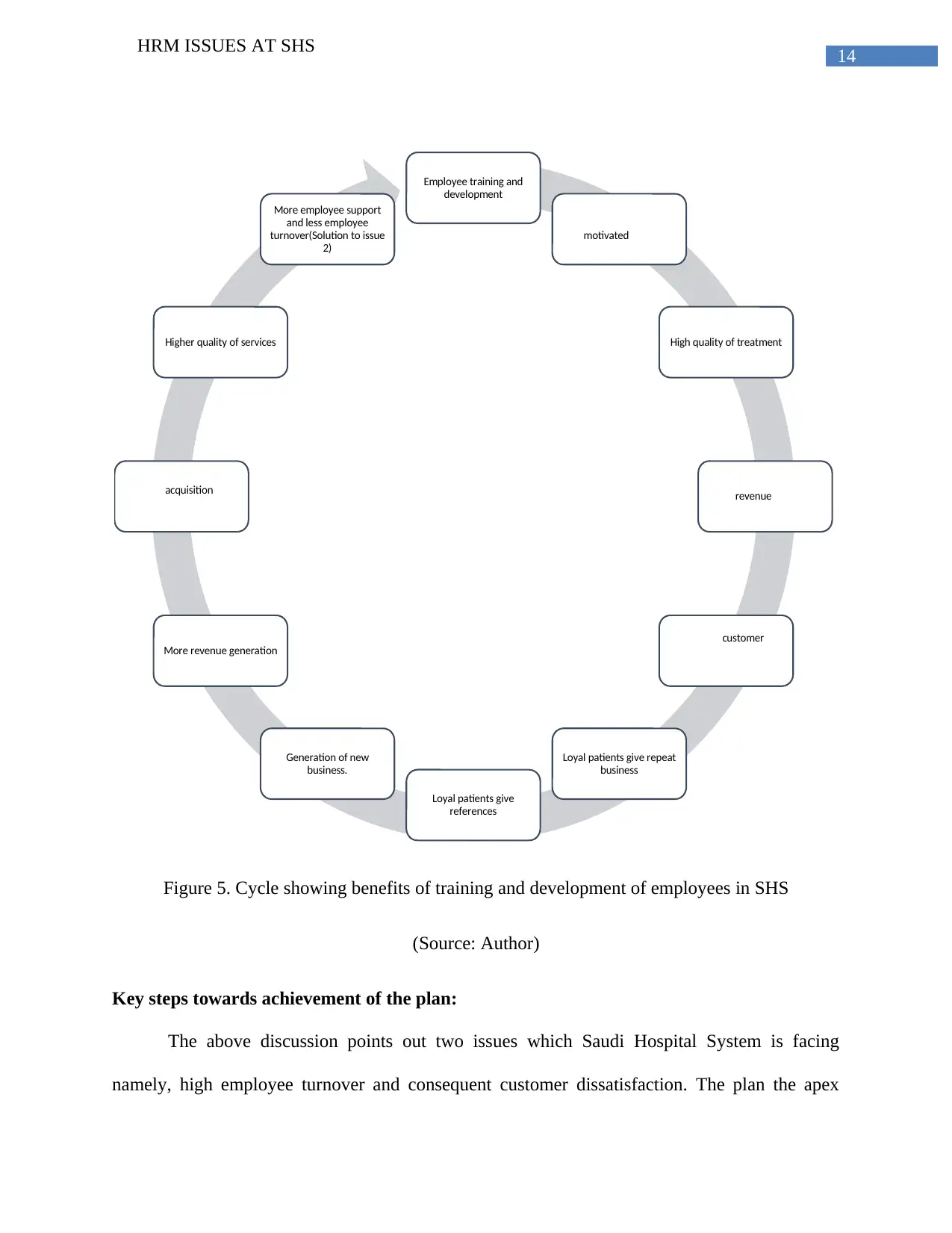
14
HRM ISSUES AT SHS
Figure 5. Cycle showing benefits of training and development of employees in SHS
(Source: Author)
Key steps towards achievement of the plan:
The above discussion points out two issues which Saudi Hospital System is facing
namely, high employee turnover and consequent customer dissatisfaction. The plan the apex
Employee training and
development
More capable and
motivated staffs
High quality of treatment
More revenue generation
Patient (customer)
satisfaction (Solution to
issue 1)
Loyal patients give repeat
business
Loyal patients give
references
Generation of new
business.
More revenue generation
More acquisition of
employees
Higher quality of services
More employee support
and less employee
turnover(Solution to issue
2)
HRM ISSUES AT SHS
Figure 5. Cycle showing benefits of training and development of employees in SHS
(Source: Author)
Key steps towards achievement of the plan:
The above discussion points out two issues which Saudi Hospital System is facing
namely, high employee turnover and consequent customer dissatisfaction. The plan the apex
Employee training and
development
More capable and
motivated staffs
High quality of treatment
More revenue generation
Patient (customer)
satisfaction (Solution to
issue 1)
Loyal patients give repeat
business
Loyal patients give
references
Generation of new
business.
More revenue generation
More acquisition of
employees
Higher quality of services
More employee support
and less employee
turnover(Solution to issue
2)
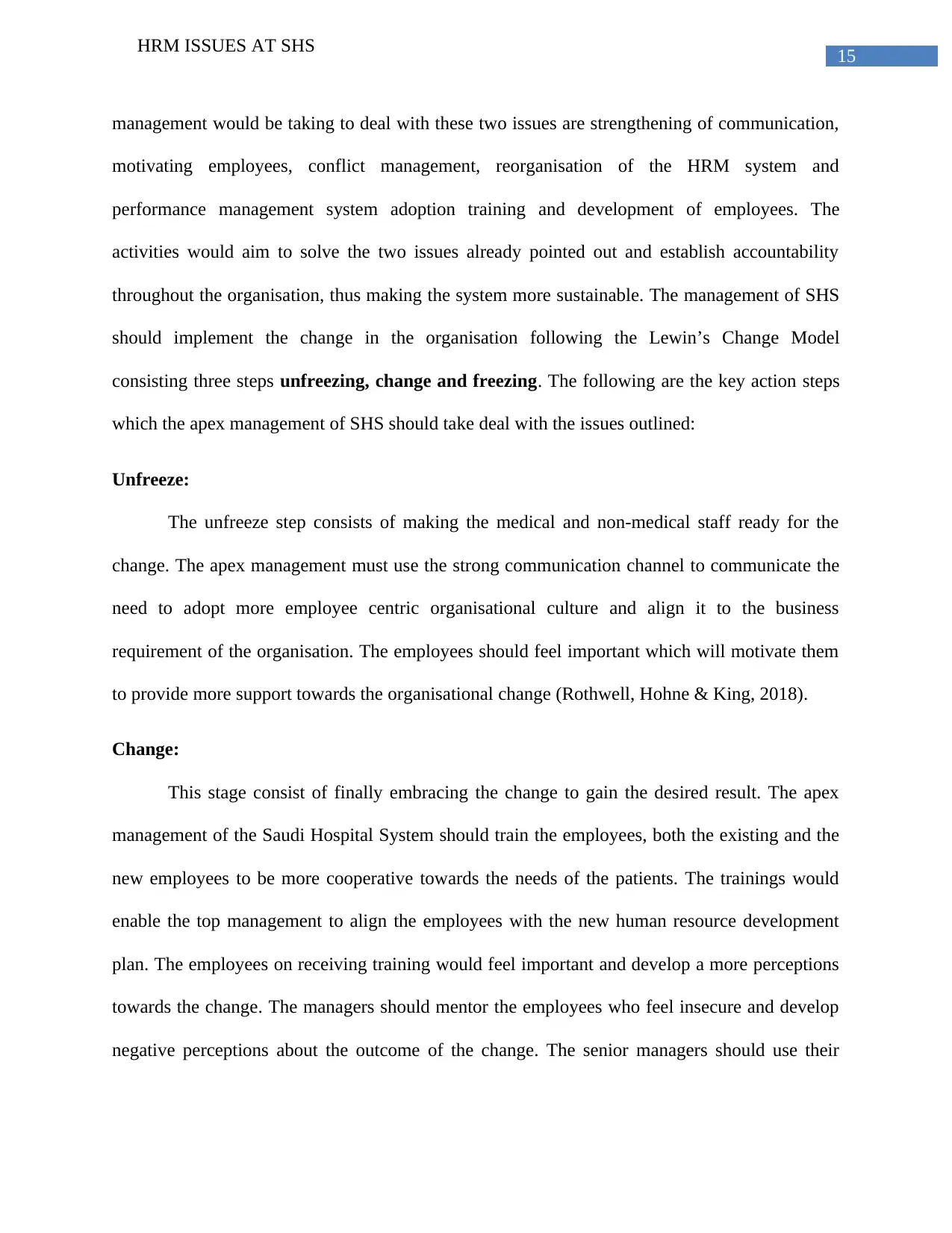
15
HRM ISSUES AT SHS
management would be taking to deal with these two issues are strengthening of communication,
motivating employees, conflict management, reorganisation of the HRM system and
performance management system adoption training and development of employees. The
activities would aim to solve the two issues already pointed out and establish accountability
throughout the organisation, thus making the system more sustainable. The management of SHS
should implement the change in the organisation following the Lewin’s Change Model
consisting three steps unfreezing, change and freezing. The following are the key action steps
which the apex management of SHS should take deal with the issues outlined:
Unfreeze:
The unfreeze step consists of making the medical and non-medical staff ready for the
change. The apex management must use the strong communication channel to communicate the
need to adopt more employee centric organisational culture and align it to the business
requirement of the organisation. The employees should feel important which will motivate them
to provide more support towards the organisational change (Rothwell, Hohne & King, 2018).
Change:
This stage consist of finally embracing the change to gain the desired result. The apex
management of the Saudi Hospital System should train the employees, both the existing and the
new employees to be more cooperative towards the needs of the patients. The trainings would
enable the top management to align the employees with the new human resource development
plan. The employees on receiving training would feel important and develop a more perceptions
towards the change. The managers should mentor the employees who feel insecure and develop
negative perceptions about the outcome of the change. The senior managers should use their
HRM ISSUES AT SHS
management would be taking to deal with these two issues are strengthening of communication,
motivating employees, conflict management, reorganisation of the HRM system and
performance management system adoption training and development of employees. The
activities would aim to solve the two issues already pointed out and establish accountability
throughout the organisation, thus making the system more sustainable. The management of SHS
should implement the change in the organisation following the Lewin’s Change Model
consisting three steps unfreezing, change and freezing. The following are the key action steps
which the apex management of SHS should take deal with the issues outlined:
Unfreeze:
The unfreeze step consists of making the medical and non-medical staff ready for the
change. The apex management must use the strong communication channel to communicate the
need to adopt more employee centric organisational culture and align it to the business
requirement of the organisation. The employees should feel important which will motivate them
to provide more support towards the organisational change (Rothwell, Hohne & King, 2018).
Change:
This stage consist of finally embracing the change to gain the desired result. The apex
management of the Saudi Hospital System should train the employees, both the existing and the
new employees to be more cooperative towards the needs of the patients. The trainings would
enable the top management to align the employees with the new human resource development
plan. The employees on receiving training would feel important and develop a more perceptions
towards the change. The managers should mentor the employees who feel insecure and develop
negative perceptions about the outcome of the change. The senior managers should use their
Secure Best Marks with AI Grader
Need help grading? Try our AI Grader for instant feedback on your assignments.
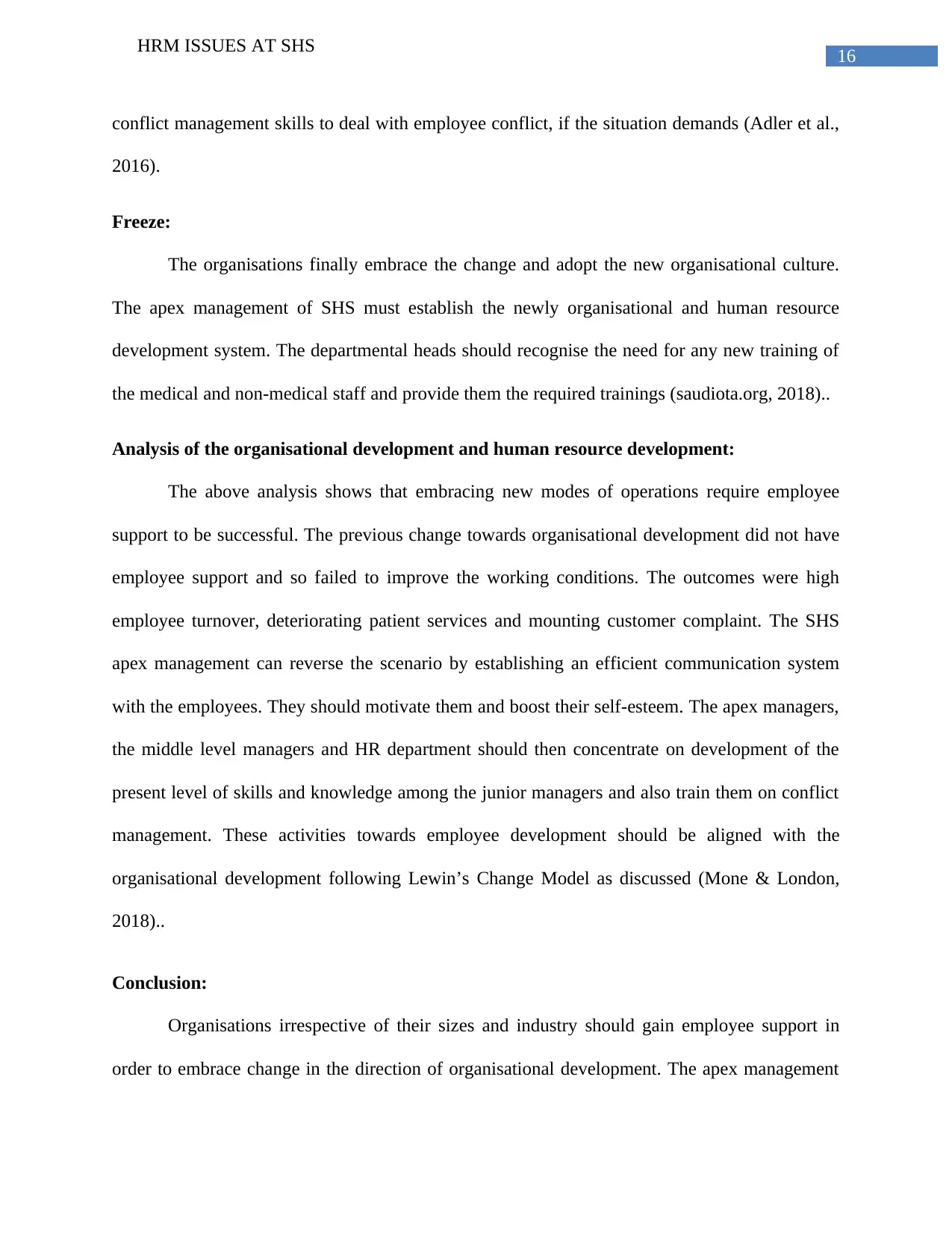
16
HRM ISSUES AT SHS
conflict management skills to deal with employee conflict, if the situation demands (Adler et al.,
2016).
Freeze:
The organisations finally embrace the change and adopt the new organisational culture.
The apex management of SHS must establish the newly organisational and human resource
development system. The departmental heads should recognise the need for any new training of
the medical and non-medical staff and provide them the required trainings (saudiota.org, 2018)..
Analysis of the organisational development and human resource development:
The above analysis shows that embracing new modes of operations require employee
support to be successful. The previous change towards organisational development did not have
employee support and so failed to improve the working conditions. The outcomes were high
employee turnover, deteriorating patient services and mounting customer complaint. The SHS
apex management can reverse the scenario by establishing an efficient communication system
with the employees. They should motivate them and boost their self-esteem. The apex managers,
the middle level managers and HR department should then concentrate on development of the
present level of skills and knowledge among the junior managers and also train them on conflict
management. These activities towards employee development should be aligned with the
organisational development following Lewin’s Change Model as discussed (Mone & London,
2018)..
Conclusion:
Organisations irrespective of their sizes and industry should gain employee support in
order to embrace change in the direction of organisational development. The apex management
HRM ISSUES AT SHS
conflict management skills to deal with employee conflict, if the situation demands (Adler et al.,
2016).
Freeze:
The organisations finally embrace the change and adopt the new organisational culture.
The apex management of SHS must establish the newly organisational and human resource
development system. The departmental heads should recognise the need for any new training of
the medical and non-medical staff and provide them the required trainings (saudiota.org, 2018)..
Analysis of the organisational development and human resource development:
The above analysis shows that embracing new modes of operations require employee
support to be successful. The previous change towards organisational development did not have
employee support and so failed to improve the working conditions. The outcomes were high
employee turnover, deteriorating patient services and mounting customer complaint. The SHS
apex management can reverse the scenario by establishing an efficient communication system
with the employees. They should motivate them and boost their self-esteem. The apex managers,
the middle level managers and HR department should then concentrate on development of the
present level of skills and knowledge among the junior managers and also train them on conflict
management. These activities towards employee development should be aligned with the
organisational development following Lewin’s Change Model as discussed (Mone & London,
2018)..
Conclusion:
Organisations irrespective of their sizes and industry should gain employee support in
order to embrace change in the direction of organisational development. The apex management
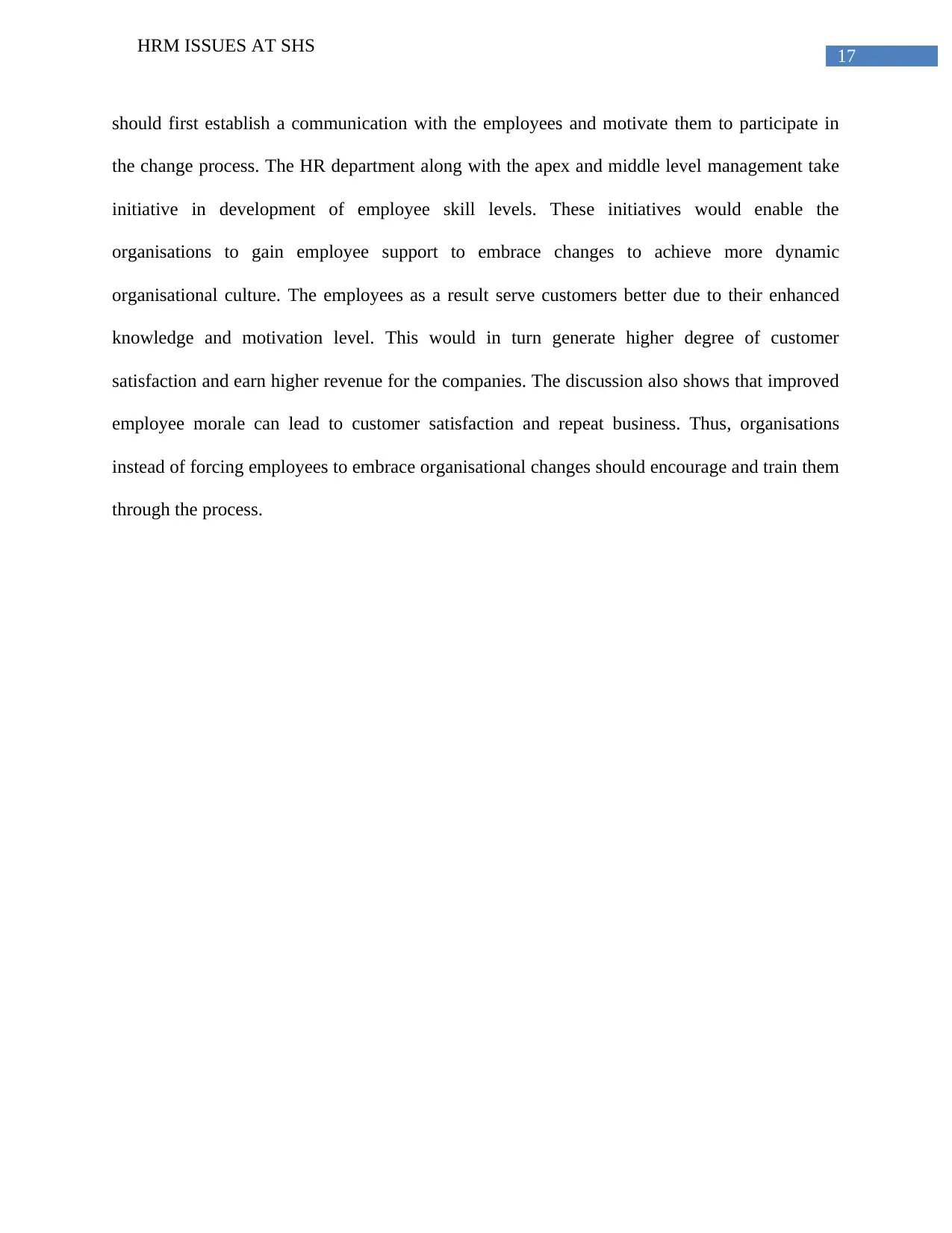
17
HRM ISSUES AT SHS
should first establish a communication with the employees and motivate them to participate in
the change process. The HR department along with the apex and middle level management take
initiative in development of employee skill levels. These initiatives would enable the
organisations to gain employee support to embrace changes to achieve more dynamic
organisational culture. The employees as a result serve customers better due to their enhanced
knowledge and motivation level. This would in turn generate higher degree of customer
satisfaction and earn higher revenue for the companies. The discussion also shows that improved
employee morale can lead to customer satisfaction and repeat business. Thus, organisations
instead of forcing employees to embrace organisational changes should encourage and train them
through the process.
HRM ISSUES AT SHS
should first establish a communication with the employees and motivate them to participate in
the change process. The HR department along with the apex and middle level management take
initiative in development of employee skill levels. These initiatives would enable the
organisations to gain employee support to embrace changes to achieve more dynamic
organisational culture. The employees as a result serve customers better due to their enhanced
knowledge and motivation level. This would in turn generate higher degree of customer
satisfaction and earn higher revenue for the companies. The discussion also shows that improved
employee morale can lead to customer satisfaction and repeat business. Thus, organisations
instead of forcing employees to embrace organisational changes should encourage and train them
through the process.
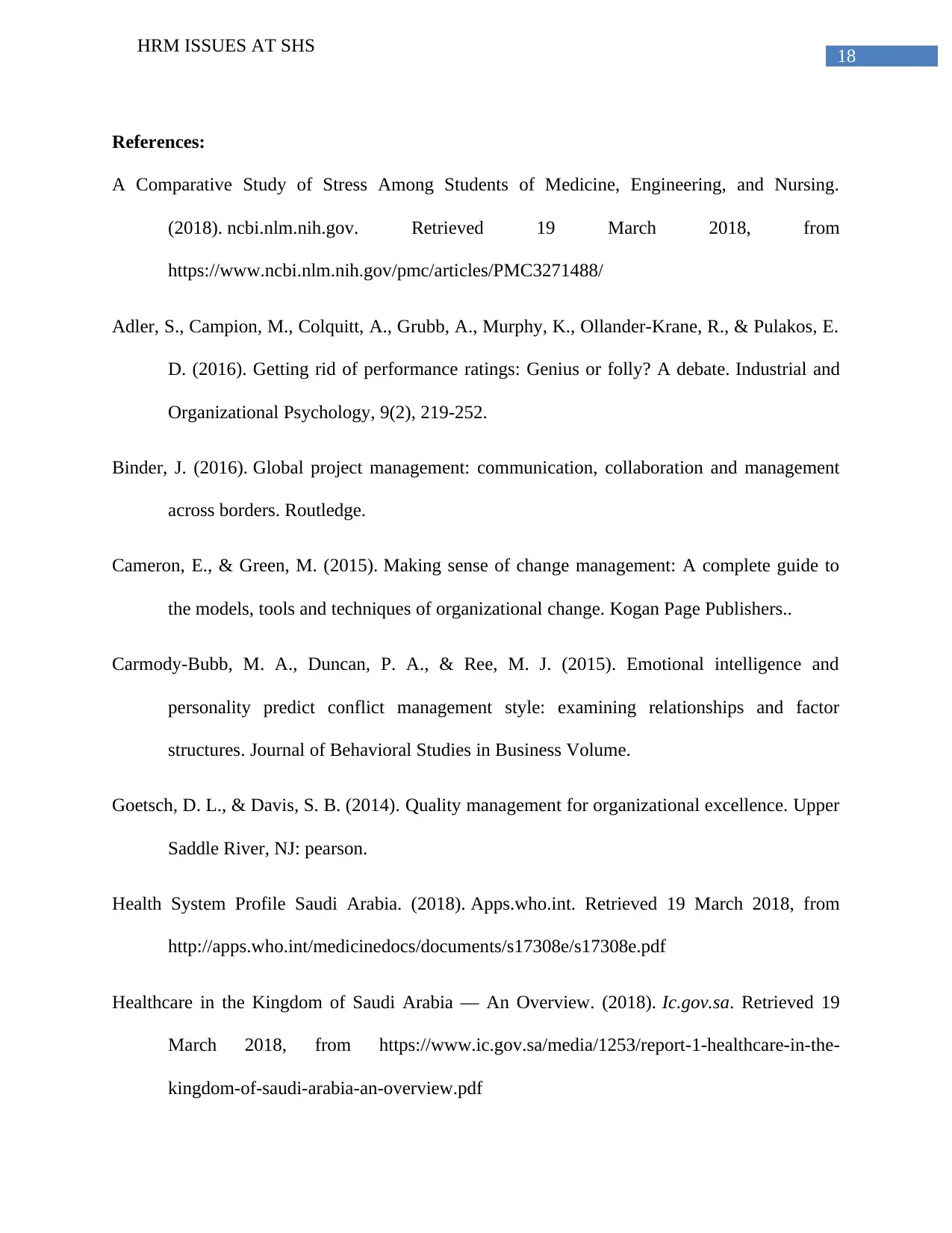
18
HRM ISSUES AT SHS
References:
A Comparative Study of Stress Among Students of Medicine, Engineering, and Nursing.
(2018). ncbi.nlm.nih.gov. Retrieved 19 March 2018, from
https://www.ncbi.nlm.nih.gov/pmc/articles/PMC3271488/
Adler, S., Campion, M., Colquitt, A., Grubb, A., Murphy, K., Ollander-Krane, R., & Pulakos, E.
D. (2016). Getting rid of performance ratings: Genius or folly? A debate. Industrial and
Organizational Psychology, 9(2), 219-252.
Binder, J. (2016). Global project management: communication, collaboration and management
across borders. Routledge.
Cameron, E., & Green, M. (2015). Making sense of change management: A complete guide to
the models, tools and techniques of organizational change. Kogan Page Publishers..
Carmody-Bubb, M. A., Duncan, P. A., & Ree, M. J. (2015). Emotional intelligence and
personality predict conflict management style: examining relationships and factor
structures. Journal of Behavioral Studies in Business Volume.
Goetsch, D. L., & Davis, S. B. (2014). Quality management for organizational excellence. Upper
Saddle River, NJ: pearson.
Health System Profile Saudi Arabia. (2018). Apps.who.int. Retrieved 19 March 2018, from
http://apps.who.int/medicinedocs/documents/s17308e/s17308e.pdf
Healthcare in the Kingdom of Saudi Arabia — An Overview. (2018). Ic.gov.sa. Retrieved 19
March 2018, from https://www.ic.gov.sa/media/1253/report-1-healthcare-in-the-
kingdom-of-saudi-arabia-an-overview.pdf
HRM ISSUES AT SHS
References:
A Comparative Study of Stress Among Students of Medicine, Engineering, and Nursing.
(2018). ncbi.nlm.nih.gov. Retrieved 19 March 2018, from
https://www.ncbi.nlm.nih.gov/pmc/articles/PMC3271488/
Adler, S., Campion, M., Colquitt, A., Grubb, A., Murphy, K., Ollander-Krane, R., & Pulakos, E.
D. (2016). Getting rid of performance ratings: Genius or folly? A debate. Industrial and
Organizational Psychology, 9(2), 219-252.
Binder, J. (2016). Global project management: communication, collaboration and management
across borders. Routledge.
Cameron, E., & Green, M. (2015). Making sense of change management: A complete guide to
the models, tools and techniques of organizational change. Kogan Page Publishers..
Carmody-Bubb, M. A., Duncan, P. A., & Ree, M. J. (2015). Emotional intelligence and
personality predict conflict management style: examining relationships and factor
structures. Journal of Behavioral Studies in Business Volume.
Goetsch, D. L., & Davis, S. B. (2014). Quality management for organizational excellence. Upper
Saddle River, NJ: pearson.
Health System Profile Saudi Arabia. (2018). Apps.who.int. Retrieved 19 March 2018, from
http://apps.who.int/medicinedocs/documents/s17308e/s17308e.pdf
Healthcare in the Kingdom of Saudi Arabia — An Overview. (2018). Ic.gov.sa. Retrieved 19
March 2018, from https://www.ic.gov.sa/media/1253/report-1-healthcare-in-the-
kingdom-of-saudi-arabia-an-overview.pdf
Paraphrase This Document
Need a fresh take? Get an instant paraphrase of this document with our AI Paraphraser
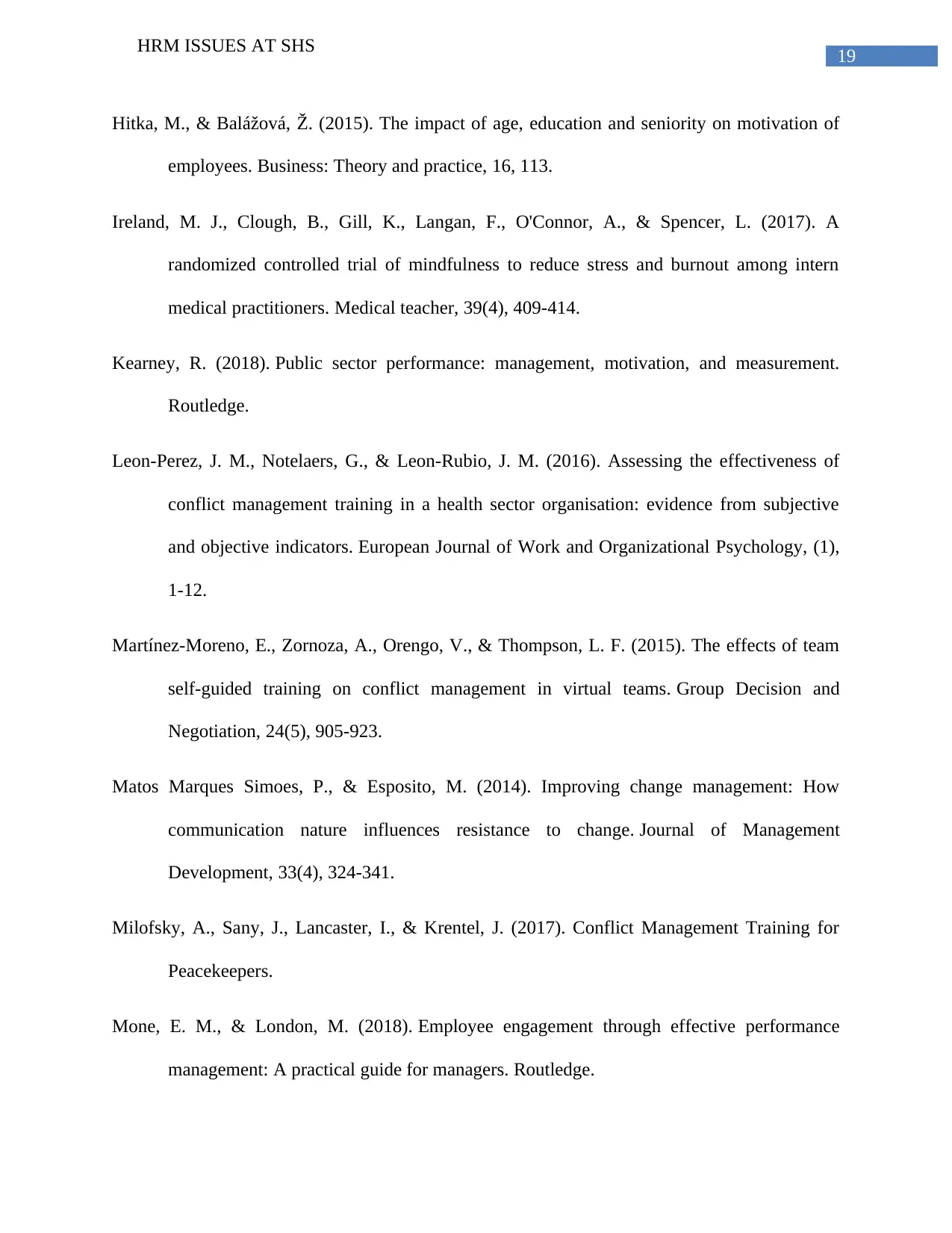
19
HRM ISSUES AT SHS
Hitka, M., & Balážová, Ž. (2015). The impact of age, education and seniority on motivation of
employees. Business: Theory and practice, 16, 113.
Ireland, M. J., Clough, B., Gill, K., Langan, F., O'Connor, A., & Spencer, L. (2017). A
randomized controlled trial of mindfulness to reduce stress and burnout among intern
medical practitioners. Medical teacher, 39(4), 409-414.
Kearney, R. (2018). Public sector performance: management, motivation, and measurement.
Routledge.
Leon-Perez, J. M., Notelaers, G., & Leon-Rubio, J. M. (2016). Assessing the effectiveness of
conflict management training in a health sector organisation: evidence from subjective
and objective indicators. European Journal of Work and Organizational Psychology, (1),
1-12.
Martínez-Moreno, E., Zornoza, A., Orengo, V., & Thompson, L. F. (2015). The effects of team
self-guided training on conflict management in virtual teams. Group Decision and
Negotiation, 24(5), 905-923.
Matos Marques Simoes, P., & Esposito, M. (2014). Improving change management: How
communication nature influences resistance to change. Journal of Management
Development, 33(4), 324-341.
Milofsky, A., Sany, J., Lancaster, I., & Krentel, J. (2017). Conflict Management Training for
Peacekeepers.
Mone, E. M., & London, M. (2018). Employee engagement through effective performance
management: A practical guide for managers. Routledge.
HRM ISSUES AT SHS
Hitka, M., & Balážová, Ž. (2015). The impact of age, education and seniority on motivation of
employees. Business: Theory and practice, 16, 113.
Ireland, M. J., Clough, B., Gill, K., Langan, F., O'Connor, A., & Spencer, L. (2017). A
randomized controlled trial of mindfulness to reduce stress and burnout among intern
medical practitioners. Medical teacher, 39(4), 409-414.
Kearney, R. (2018). Public sector performance: management, motivation, and measurement.
Routledge.
Leon-Perez, J. M., Notelaers, G., & Leon-Rubio, J. M. (2016). Assessing the effectiveness of
conflict management training in a health sector organisation: evidence from subjective
and objective indicators. European Journal of Work and Organizational Psychology, (1),
1-12.
Martínez-Moreno, E., Zornoza, A., Orengo, V., & Thompson, L. F. (2015). The effects of team
self-guided training on conflict management in virtual teams. Group Decision and
Negotiation, 24(5), 905-923.
Matos Marques Simoes, P., & Esposito, M. (2014). Improving change management: How
communication nature influences resistance to change. Journal of Management
Development, 33(4), 324-341.
Milofsky, A., Sany, J., Lancaster, I., & Krentel, J. (2017). Conflict Management Training for
Peacekeepers.
Mone, E. M., & London, M. (2018). Employee engagement through effective performance
management: A practical guide for managers. Routledge.
1 out of 20
Related Documents
Your All-in-One AI-Powered Toolkit for Academic Success.
+13062052269
info@desklib.com
Available 24*7 on WhatsApp / Email
![[object Object]](/_next/static/media/star-bottom.7253800d.svg)
Unlock your academic potential
© 2024 | Zucol Services PVT LTD | All rights reserved.





